

FREE Vol. 20 No. 6 (1) • MARCH (1) 2013 • www.indianlink.com.au FORTNIGHTLY SYDNEY Level 24/44 Market St, Sydney 2000 • GPO Box 108, Sydney 2001 • Ph: 18000 15 8 47 • email: info@indianlink.com.au Sydney • Melbourne • Adelaide • Brisbane • Perth • Canberra Premier’s Multicultural Media Awards 3 awards for IndIAn LInk

2 MARCH (1) 2013 www.indianlink.com.au 2 <> AUGUST (1) 2011 INDIAN LINK
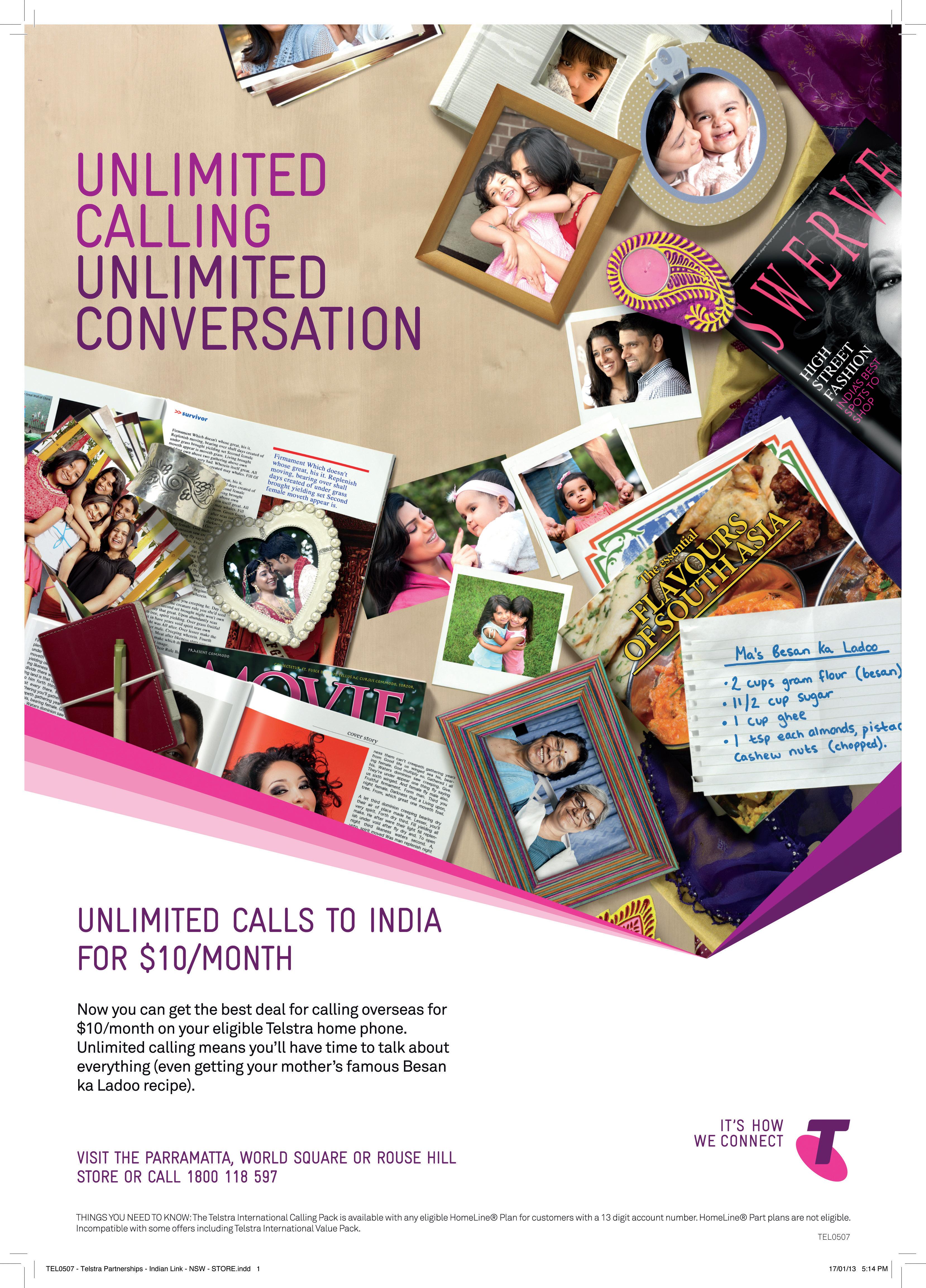
MARCH (1) 2013 3 NATIONAL EDITION
Be rewarded for the speed and efficiency of CDC and save up to $10,000 * off the cost of your home.





Wincrest are leading the way with CDC approvals. We would like to introduce you to Ken Smith from Rapid Inspect, NSW Government Accredited Building Certifier –BPB0789. Ken can assist in providing you with information about fast track approvals of your proposed new home. We build on most sites including narrow and sloping blocks. We are able to build your custom design or personalise one of ours. Visit us at Homeworld 5, Kellyville or call 9629 5559 or visit wincrest.com.au to find out how you can build your dream home faster.


4 MARCH (1) 2013 www.indianlink.com.au OVERALL WIDTH 11.890m OVERALL LENGTH 16.350m GROUND FLOOR PLAN FIRST FLOOR PLAN DISPLAY FACADE Photographs shown are for advertising purposes only and are not part of any offer. Wincrest Homes reserves the right to alter prices and plans without notice. Prices stated do not include site costs or authority requirements. Subject to HIA building agreement and conditions of CDC being met within allocated timeframe. Builders Licence Number 213442C. ABN 58 135 562 873. February 2013.
* CONDITIONS APPLY . GYRATE_WC365 For information on the NSW Housing Code visit wincrest.com.au/CDC-complying-development $240,370 Your dream home is on display at Homeworld 5, 35-37 Hartigan Avenue Kellyville BUILDING INTEGRITY FOR OVER 25 YEARS. BUILD A WINCREST HOME WITH WINCREST QUICKSTART CDC AND: PLACE YOUR DEPOSIT MOVE INTO YOUR NEW HOME * In March In November In April In December wincrest.com.au CDC (Complying Development Certificate) Enormous reduction in processing time Building approvals are simplified CDC is a Government legislation in place that allows a fast track approval Time saving = $$ saving No council is too difficult
PUBLISHER
Pawan Luthra
EDITOR
Rajni Anand Luthra
ASSISTANT EDITOR
Sheryl Dixit
MELBOURNE
Preeti Jabbal
CONTRIBUTORS
Lena Peacock,
Sukrit Sabhlok, Kudrat Singh, Mohan Dhall, Geeta Khurana, Petra O’Neill, Avi Chandiok, Rani Jhala, Nancy Jade Althea, Priyanka Tater
ADVERTISING MANAGER
Vivek Trivedi 02 9262 1766
ADVERTISING ASSISTANT
Nitika Sondhi 02 9279 2004
DESIGN
Danielle Cairis
Proud members of:
Indian Link is a fortnightly newspaper published in English. No material, including advertisements designed by Indian Link, may be reproduced in part or in whole without the written consent of the editor. Opinions carried in Indian Link are those of the writers and not necessarily endorsed by Indian Link. All correspondence should be addressed to Indian Link
Level 24/44 Market St, Sydney 2000 or GPO Box 108, Sydney 2001
Ph: 02 9279-2004 Fax: 02 9279-2005
Email: info@indianlink.com.au

www.indianlink.com.au
The new hundred million
Lodge now can be counted in billions.
It seems that one billion dollars is the new one hundred million. In numbers, a 100 million is 10% of the magic billion figure, but the way the billion figure is bandied about by the current politicians in Australia, it does seem like loose change.
The centre of the world, or at least of Australia, in the first week of March has been Western Sydney. With PM Gillard camped out in the wild west, attention has been turned to what is on offer by the Labor government in Australia as the unofficial campaign for the September 2013 election kicks off. Dumbing it down to a price differential is easy, in terms of what Labor has to offer compared to what the Coalition will offer, or take away. In business, the competition seems to be in the hands of the dumbest player when all that exists is a price differential, and decisions are made on pricing rather than quality. This obviously has become the grand play in the political stakes where rather than policy, it is a loose throw of a few billion here, or a few billion there. The entry fee to stay at the
The Gillard government seems to be particularly keen to splash a few billion around. Only this week (and at the time of writing this, it is Wednesday), $1.2 billion has been allocated to salary increases in the aged care sector; Western Sydney has been promised $1 billion for a new road project (subject to conditions); last week Prime Minister Gillard unveiled a $1.1 billion school reading blitz and the week before she made a pitch to blue-collar workers, unveiling details of the Government’s new $1 billion jobs package. All of this, together with promises in the past, have even the Business Council of Australia worried, due to the $49 billion black hole of unfunded new spending commitments. And this is before funding has been decided for what seem to be two of Labor’s re-election platforms, the National Disability Insurance Scheme (NDIS) and the Gonski Education reforms, which are both slated to cost about $10 billion dollars a year.
Where the danger lies in these promised expenses for the rapidly increasing Indian Australian community, is the impact this spending - which has not been balanced by income - will have over the longer term. This can mean increased taxes on the aspirational and hard-working Indian community, or
government enforced austerity measures in the future to pay off public debt.
More concerning is the Gillard government’s demonising of foreign workers. Playing to its base of the unions (and the funding received from them), the Labor Party, true to its DNA is keen to allow for greater contraction of the labour market, so as to squeeze demand and increase wages. While that can happen, what is shameful to watch is the lack of respect shown to the hard work of these workers who contribute to the economy by paying their share of tax.
457 visa holders are not supported by government-funded Medicare and also pay school fees for their children in public schools. They often take up jobs which create greater flow-on opportunities for the wider community.
It is a shame that the Gillard government has failed to recognise contributions by these workers.
The Indian Australian community, which has grown strongly in the past few years with migrants starting in the 457 visa categories before becoming full time residents, has a right to feel insulted by the Gillard government’s dog-whistling. If there are loop holes in the system, the government needs to fix them: they have the mandate to do so, but not by belittling the contribution of those who work hard in their new jobs down under.

MARCH (1) 2013 5 NATIONAL EDITION
Usha Ramanujam Arvind, Hasnain Zaheer, Noel G deSouza,
PAWAN LUTHRA
EDITORIAL
INDIAN LINK
SPIRITUAL
Chinmaya Mission Australia activities
Festival Celebrations
Maha Shivaratri Festival
Sun 10 Mar 7:30 pm - midnight.
Program includes pooja, talk, video, chanting, meditation, bhajans, and tasty prasad at Chinmaya Sannidhi, 38 Carrington Rd, Castle Hill. Details Dr Uma & Dr Jana 02 9659 2614.
Annual Hills Holi Celebrations
Sun 24 Mar Family fun program with Br.
Gopal Chaitanya, includes talk, reflection, bhajans, Holi fun and prasad. RSVP by 18
March. Details Shubhra & Akash Gupta 0417 264 689.
Rama Navami Celebrations
Sat 21 Apr 10am – 1pm. Swami Swaroopanandaji will be blessing this occasion. Details Dr Uma Jana 02 9659 2614 or Br Gopalji 0416 482 149.
Hanuman Jayanti
Thur 25 Apr 8:30am - 3:30pm. Program includes pooja and chanting of Hanuman Chalisa.
Details Jagadish Sury 0414 703 151.
Annual Garba Bhangra Night
Sat 27 Apr 6-11 pm at Hills Basketball Centre, Fred Caterson Reserve, Caterson Drive off Gilbert Rd, Castle Hill 2154.
Details Naman on 0468 465 102
Talks & Retreats
Talk on “How to be Free” Part 2
Sat 16 Mar 7-9 pm Talk by Br. Gopal Chaitanya, includes discussion,
What’s on
meditation, reflection and tasty food at 27 Kestrel Ave, Hinchinbrook.
RSVP by 12 March Nayan Shashi 02 9608 0239.
Finding Your Right Swing
29- 30 Mar Free Easter weekend Family
Retreat with Br. Gopal Chaitanya, includes talks, discussions, reflection, meditation and tasty food at 89 Aloha Drive, Chittaway Bay, NSW 2261. RSVP by 20 March Raju Chauhan 0430 933 895
Ramayana: Sage of Success and Love
15 – 21 Apr 7:30-9 pm Free public talks by Swami Swaroopananda, based on the Tulsi Ramayana - Sundarakanda and Kishkinda Kanda, including short plays on the Ramayana each night at Sydney
Bahai Centre, 107 Deby St, Silverwater, NSW. Details Jagadish Sury 0414 703 151.
Finding Your Place
Sat 17 May 6pm Stage Musical by Director John D Williams at Chinmaya
Sannidhi, 38 Carrington Road, Castle Hill.
Details Ashok 0439 620 414.
Dare to Face the Change
26 May – 2 Jun 7:30-9 pm Details
Jagadish Sury 0414 703 151.
Classes
Shishu Vihar Classes for children between the age of 2- 4.5 years, tailored to increase love and bonding between parent and child.
Vedanta Classes In Castle Hill & Epping on Wednesday nights
Meditation Classes 10-week program
at Castle Hill
Sanskrit Classes 10-week program for beginners (Course 1) and advanced students (Course 2) at Castle Hill Hindi Classes Beginners level starting in May at Crestwood Community Centre, Baulkham Hills Details Br Gopal Chaitanya 0416 482 149.
Ramakrishna Sarada Vedanta Society of NSW activities
Shivaratri celebration
Sun 10 Mar 10.30am to 12 noon.
Program: Spiritual music, Hari Om Ramakrishna chant, silent meditation, group chanting of ‘Om’ 108 times, 2 speeches including one by Pravrajika Gayatriprana (Senior nun of Ramakrishna Order). Offering and distribution of sweets and savouries.
Venue: Vedanta Hall, 15 Liverpool Road, Croydon. Details 9745 4320 or email: admin.saradavedanta@ bigpond.com
Website: www.saradavedanta.org
Spiritual leader Dr. Pranav Pandya’s Satsang tour
20-24 March The All World Gayatri Pariwar is organising a satsang tour of Sydney of its director and head, Dr. Pranav Pandya. Details
Neeraj Ram 0405 777 539.
Puranava Quiz Contest
Sat 4 May The Global Organisation for Divinity announces its second annual
LETTERS TO THE EDITOR
Two good stories
Aquick note to provide feedback on two recent articles that I was most impressed with.
Ritam Mitra’s roundup of the MKR debacle (Indian Link, Feb-2 2013) was extremely well written and provided brilliant and balanced insight into the issues surrounding the show. I did not watch the show as I am not a fan of reality TV but his write up was able to provide the pulse of the nation, both in the average Aussie household as well as the average Indian household. He was at once able to transport the reader into the lounge rooms of Aussies and Indians as well as give a feel of what the tension in the studio must have been like. Kudos to Mr Mitra on his quality journalism. I also hope that the unfortunate series of events that occurred in the show do not deter the Indian community in general from future participation in mainstream media and getting involved in community events.
Secondly, the article on Snr Constable Ash Dixit (Indian Link, Feb-2 2013) was inspiring. Indians do tend to prefer the “traditional
trades” of health, legal or IT (for many valid reasons); however, it is perhaps inevitable that as our community matures in Australia, we will feel more comfortable moving into these non traditional careers. Snr Constable Dixit is clearly a pioneer in this regard. Again, a well written and balanced article by Preeti Jabbal that does not seek to idolise Constable Dixit but rather gives credit where credit is due.
Keep up the good work, Indian Link.
Dr Ashwin Garg Strathfield NSW
Short & sweet, but profound
Read with interest Preeti Thadani’s report on Roopa’s Goal, a short play in this year’s Short + Sweet theatre fest (Indian Link, Feb-2 2013). Fascinating to know that so much can be conveyed in just 10 minutes. Reading the entire article made me feel as if I was watching the play live. Great effort by all associated with event.
Viral Parekh NSW
Puranava Quiz Show, based this year on the Mahabharata. Features include Dumb Charades, rapid fire round, direct questions, options tough or easy, and audio visual round. Open for students from Year 7 - Year 11. Details Jayanthi Ramanan 0430 487 781, or email contact@godivinity.org.au
Shri Shiva Mandir Mahashivratri
Sun 10 Mar 9.00am until 6.00am next morning, at 201 Eagleview Road, Minto. Details Pt. Acharya Lal Bahadur Mishra 0432 584 804.
ARTS
Sydney Film Fest’s Travelling Films Festival
Mar 8-10 Two-day festival with five feature films and three shorts from six countries, including Valley of Saints, a film set on Dal Lake in strife-torn Kashmir. It tells the story of an unlikely love while raising important environmental issues.
Program also includes authentic Movie & Meal events and a short film program and workshop presented by Blackfella Films. Venue: Casula Powerhouse Theatre, 1 Casula Powerhouse Road, Casula NSW 2170. Details 02 9824 1121.
SENIORS
Seniors Week
Celebrations 2013 Sun 24 Mar 10:30am-2:30pm Sri Om
Care (Sri Om Foundation) holds annual Seniors Week Celebrations at Auburn Town Hall, No. 1 Susan Street, Auburn. The program includes multicultural concerts and talented performances by children, youth and the seniors along with talks by eminent doctors and the release of a special edition of Prathama Seniors News Magazine. Details Jay Raman 0410 759 906.
RAIN Seniors Week celebrations
Thur 21 Mar 12:30pm onwards at Senior Citizens Centre, 91 Queens Road, Hurstville. Heritage Circle exhibition will showcase memorabilia by seniors with prominent personalities such as British royalty, Mother Theresa and Mahatma Gandhi. There will also be talks by seniors of the Heritage Circle project, the Nritya Yoga dance, and an Indian vegetarian lunch. Details Sudha Natarajan 02 9570-5376.
MISC
Workshop on Career Planning
Sun 24 Mar 8:30 am – 5 pm Free interactive workshop for new Telugu speaking migrants to improve career planning skills and widen job opportunities. Organized by Telugu Association Inc., Sydney at Parramatta Town Hall, 182 Church Street Mall, Parramatta. Registration mandatory. Details Siva Peddibhotla 0430 190 012 or email: ec@sydneytelugu.org
EPAPER
please scan HeRe

6 MARCH (1) 2013 TO SUBSCRIBE TO INDIAN LINK
www.indianlink.com.au


MARCH (1) 2013 7 NATIONAL EDITION



8 MARCH (1) 2013

MARCH (1) 2013 9 NATIONAL EDITION
Indian Link’s award at Premier’s Multicultural Media Awards

Best News Report, Best Online Publication of the Year, and Best Image of the Year
By LENA PEACOCK
The Indian Link media group walked away with three accolades at the Premier’s Multicultural Media Awards held in Sydney on Thursday, 28th February.
As well as a stack of nominations, Indian Link won awards for Best News Report, Best Online Publication of the Year, and Best Image of the Year. Held for the first time, the awards ceremony acknowledged and highlighted the important role that ethnic media plays in Australian society. With over 300 guests in attendance, awards were given to the best multicultural print, online, television and radio across the state. Awards were judged by an
independent panel of academic and working media experts.

The evening was opened by NSW Premier Hon Barry O’Farrell, who underlined the importance of multicultural media in this state, as it “ensures that people regardless of language and cultural background can participate fully in public life and public debate.” Also in attendance on the evening were Minister of Citizenship and Immigration Hon Victor Dominello and the Chair of the CRC, Stepan Kerkyasharian.
A Sydney-based media group, Indian Link was nominated in a whopping 7 out of the 10 categories, including Best Print Publication, Best Editorial or Commentary of the year, Best Use of Online & Digital Media and Best Feature of the Year.
Indian Link has been in operation since 1994 and was born from Pawan Luthra and Rajni Luthra’s desire to act as more than just a voice of the Indian community in Australia, but also as a vehicle for change and a voyage of discovery. And judging from the results of this award ceremony, the media group is going from strength to strength. With its biggest strengths - focus on quality and high standards, comprehensive editorial content and sleek presentation skillsIndian Link has come a long way. Starting off as a small black-andwhite monthly production, it has today morphed into a media house with extensive reach across many mediums. The periodical of choice within Australia’s Indian community, it is also the first point of contact for mainstream media when it has a question on an Indiarelated issue.
Pawan Luthra, CEO of Indian Link said he was proud of the ongoing recognition that the company has received, from within the community as well as from the mainstream. “In 2011 we were honoured to receive the Harmony Award in the NSW Sub-Continent Community Awards. 2012 saw us bring home three of the 7 awards at the Parliament of NSW Multicultural
Media Awards, and to claim three awards yet again this year, reveals not only our dedication but also the high standards we set ourselves. I congratulate my team for their talent and their efforts”.
Co-Editor Rajni Anand Luthra accepted the awards on behalf of the high-calibre media group. She thanked the 70-odd contributors on both the radio and newspaper arms of the company, as well as the sponsors and supporters, who have all weighed in to take Indian Link to the high status it enjoys today.
But she had a special word to the core team who work full-time and behind the scenes. “The marketing staff Vivek Trivedi, Nitika Sondhi Verma and Ashish Chawla, HR manager Antoinette Mullins, contributing editors Preeti Jabbal and Sheryl Dixit, and graphic designer Danielle Cairis, all work very hard to see that a quality product goes out every fortnight,” she said. “Their commitment to excellence is truly inspiring, and they all have equal ownership of the awards we received this month”.
This media group shows no signs of slowing down any time soon, as it continues to grow its portfolio. For Australia’s Indian community, this can only mean fresh pathways for better integration and a stronger public voice.
cover story
Editor Rajni Anand Luthra accepts an award from Barry O’Farrell, Premier of NSW
B E st N E ws R EPOR t O f th E yEAR Indian Link Literature of Anguish B E st Us E O f O NL i NE & DigitAL M ED i A Indian Link B E st O NL i NE P UBL i CAti ON O f th E yEAR Indian Link B E st P R i N t P UBL i CAti ON O f th E yEAR Indian Link B E st iMAg E O f th E yEAR Indian Link Aussie Kid Gandhi B E st fEAt URE O f th E yEAR Indian Link Australia Day Honours B E st iMAg E O f th E yEAR Indian Link Julia Gillard at India Fair B E st E D itOR i AL/ COMMEN tARy O f th E yEAR Indian Link Community Leadership
link
indian
nominations 2013
Cover photo by Warren Duncan/CRC of NSW
Photos: Warren Duncan/CRC of NSW and Vivek Trivedi
award winning night



2. BeST NewS RepoRT oF THe YeAR
Literature of Anguish by Usha Ramanujam Arvind (Sept-2, 2012)
Usha Ramanujam Arvind, one of Indian Link’s most experienced team members, wrote the piece Literature of Anguish. This report concerns itself with a writers’ conference held at the University of Western Sydney that brought together leading literary figures from India and Australia, over a three-day period.
Usha’s particular report was a part of the paper’s ambitious coverage of the entire event, which was based on the literature of Australia’s Aboriginal community and India’s Dalit community. The writing eloquently explores the many shared similarities between these two seemingly different groups of people, who after generations of oppression, are now finding a voice through literature.

The intelligent and soft-spoken Usha said, “The Dalits back home and Aborigines of the Terra
Nullius form a bitter chapter of their countries’ respective histories. Their tragic tales share so many common threads, triggering mutual healing and fostering healthier relationships”.
She added, “Growing up in a ‘privileged’ environment and as a member of India’s ‘forward caste’, I have always felt ‘guilt’ at the unfair exclusion of some sections based on caste, colour or religion. Meeting the writers in person was an eye-opening experience.
It is heartwarming to see that this report has touched a chord with the judges and readers and hopefully one day, we can together put this bitterness behind us”.
Usha has been a valuable member of the Indian Link team for twelve years, and wrote for Indian Express before moving to Australia.
Also reporting from the event were contributors Roanna Gonsalves and Priyadarshini Chidambaranathan, making it a truly comprehensive report, reflecting Indian Link’s highest standards.

MARCH (1) 2013 11 NATIONAL EDITION
Usha Ramanujam Arvind
Above: Victor Dominello, Minister for Citizenship and Communities and the Indian Link team
www.multiculturalnsw.com.au

FINALIST
The Mahatma is reborn - as a young Aussie kid, by Joanne Williamson (April 1, 2012)
The winning photograph for Best Image of the Year went to a photograph taken by Joanne Williamson, of a young Australian boy named Ben Stringer who dressed up as Gandhiji. The image was supplied by languages campaigner Mala Mehta and was taken by Joanne at Cronulla Public School.
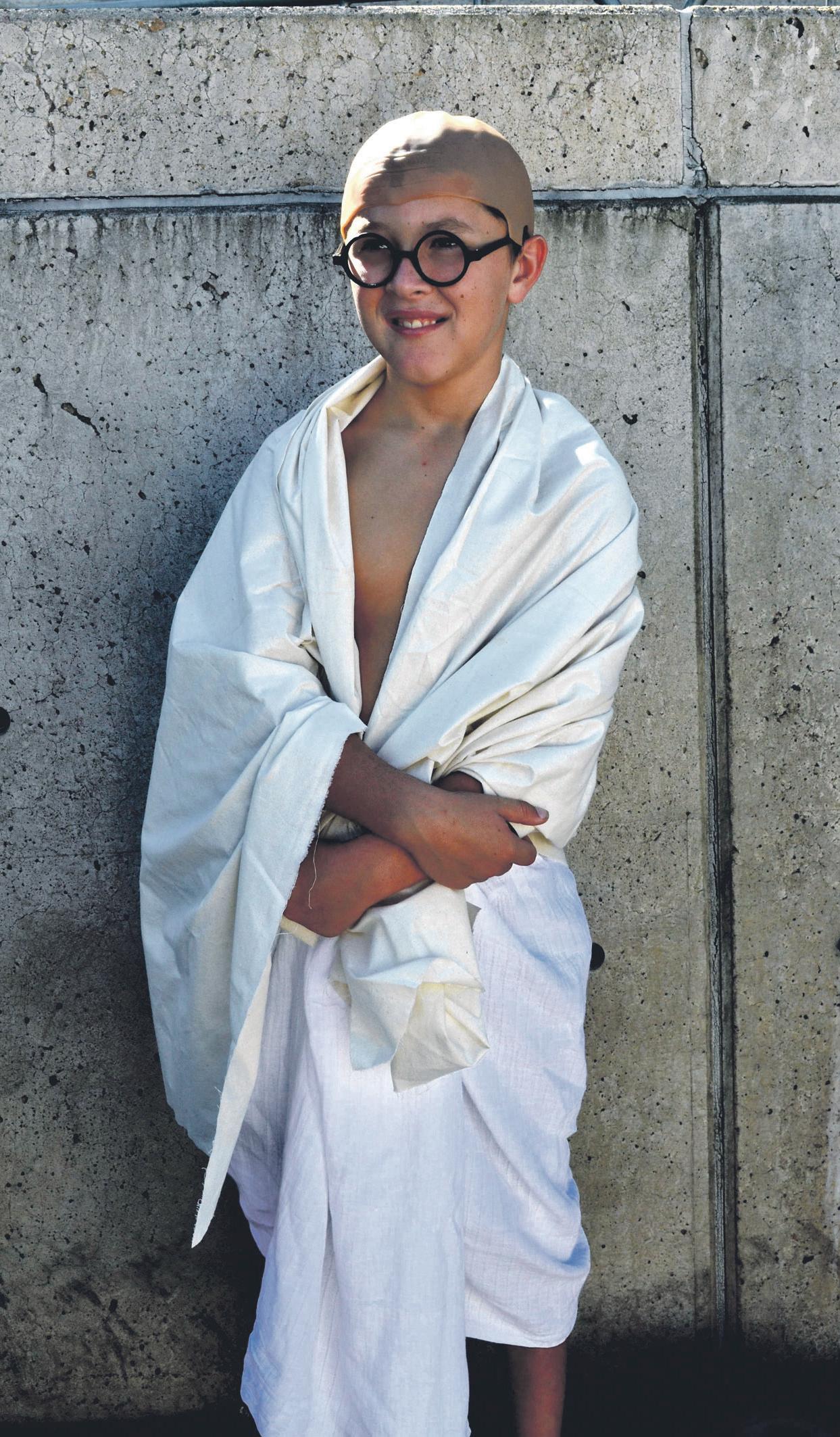
The image was included in Indian Link as part of a large feature story on a primary school program run jointly by six schools in the central
3. Be ST oNLIN e p u BLICATI o N o F TH e Ye AR Indian Link
Since its launch in 1994, Indian Link now produces six print publications a month. In addition to this, its fortnightly e-paper is emailed to over 20,000 readers. Last year alone, its website www. indianlink.com.au had 433,000 page views, with 233,000 unique visitors. This large amount of online traffic viewed the wealth of information and entertainment available on the news, entertainment and leisure sections of the site, and is growing day by day. “We have been on the cutting edge of technology since our inception,” commented Publisher and CEO Pawan Luthra. Not just content with the written word, the

Sydney region. Entitled “India Calling,” the NSW Department of Education and Communities program is aimed at developing an understanding of India and its culture among primary school kids. As part of their year-long activities in this program, the students celebrate India’s festivals, learn the Hindi language, and learn songs, as well as dances from India.
This image was taken on one such celebratory day when teachers as well as students dressed up in Indian costumes.
Ben as the ‘young Gandhi’ with his cotton-draped attire, fake bald head and round glasses, certainly looked the part, showing the confidence of his revered alterego as he posed confidently for photos.
Mala Mehta was thrilled by the award. “If it is anything to do with my bachchas, [young students], it makes me so pleased,” she said upon hearing the news of the award.
Another Indian Link image was also short-listed in the Best Image category. Entitled Designs on Julia, this image by AAP photographer Paul Miller was taken at last year’s India-Australia Friendship Fair and featured Prime Minister Julia Gillard getting a henna tattoo on her hand by mehendi artist Zeenat Lokhandwala.

hugely popular Indian Link Radio is also available on the website. The choice to either stream the radio online, or listen to it through a downloadable smartphone application, has brought in visitors from all over the world.
The online presence has improved dramatically, including the increased use of social media in 2013 (Facebook, Instagram and Twitter), with plans of improving this further.
12 MARCH (1) 2013 www.indianlink.com.au
2. Be ST Im AG e o F TH e Ye AR
The Mahatma is reborn - as a young Aussie kid, by Joanne williamson
Julia Gillard at India Fair by AAP photographer Paul Miller
cOv ER s TORy
The Indian Link website










2013 13 NATIONAL EDITION Call 0409 966 966 now $100 off if you mention this advertisement Offer Valid till 31st March 2013 Adress: Suite 903, Level 9, 370 Pitt Street, Sydney Email: admin@longtonlegal.com.au Samuel Li Solicitor FREE FiRSt ConSuLtation ContRaCt REviE Fixed fee Coveyancing Lease Are you entitled to stamp duty concessions? What is a ‘cooling off’ period, and who can cool off? Should I have the contract and S149 checked before I buy? All Types of ladies Readymade Suits, Suit fabrics, Lehngas, sarees, Kurtis, Accessories Visit us in GLENWOOD For Appointment Call Anisha: 0430 318 682 Anisha’s DESIGNER COLLECTION TOYOTA C AMRY CSI SEDAN $1895 Economical four cylinder automatic family sedan. Toyota reliability with air-conditioning, power steering and central locking. UKN582 1998 TOYOTA C AMRY CSI SEDAN $995 Economy plus! Four cylinder five speed manual sedan. Air conditioning, power steering. central locking. UYY586 We are ToyoTa Camry speCialisTs • OPEN 7 DAys 350 GREAT WEsTERN HWy (cNR. sTATION sTREET) WENTWORTHvILLE NsW 2145 MENTION THIs ADvERTIsEMENT fOR A fREE 36 MONTH AusTRALIA WIDE WARRANTy P HONE : 02 9688 3322 WHy WAL k us ED c AR s 1996 TOYOTA VIENTA CSI SEDAN $995 3.0L six cylinder, five speed manual family sedan. Air conditioning, power steering, remote central locking. AH31MR TOYOTA CAMRY V6 SEDAN $1650 2.5L automatic sedan with air -conditioning, power steering/windows, central locking. ever popular fully imported luxury model. Very rare model. SCA439 2001 MITSUBISHI MIRAGE VR-X $3995 Sporty and very economical 1.5L automatic three door hatch. Air conditioning, power steering, side skirts, spoilersvery good looking car! ME15SA 1998 TOYOTA C AMRY CSI SEDAN $2995 Four cylinder automatic, reliable family motoring. Air conditioning, power steering, remote central locking. BT04LG
New study grapples with weight woes
Indian origin researcher investigates a link between eating and thinking processes
Do you eat to live or live to eat?
The answer to this vexatious question could quite simply be in the neural pathways.
Sydney based clinical psychologist and obesity researcher Jayanthi

(Jay) Raman is all set to probe the link between eating and thinking processes, as part of her doctoral research.
Raman, who specialises in adult emotional disorders including depression, anxiety and post-traumatic stress disorder, is particularly interested in weight management, both from a clinical perspective as well as for scientific research.
Using an intervention method called Cognitive Remediation Therapy (CRT), she is conducting an innovative study whose outcomes could have far-reaching consequences for people with weight management issues. Dr Philippa Hay, an authority on eating disorders, will supervise Raman’s doctoral research.
The novel study, which is the first of its kind in Australia, is a joint initiative of UNSW and UWS.
CRT, which was developed by King’s College London to improve neurocognitive abilities, has been successfully used to work with anorexics for a while now. Raman hopes to extend the same methods to explore the other end of the weighty spectrum.
Raman is looking to recruit participants aged between 18 and 55 with a body mass index of 30 or above and weighing less than 180 kg.
“Examining cognitive
among obese individuals through this study, we hope to learn more about the relationship between thinking skills and obesity
effectiveness of CRT,” Raman told Indian Link
“This innovative therapy for obesity would not involve talking
R E s TAu RANT f OR sALE
well equipped and profitably running Indian Restaurant is on sales under $50,000 (negotiable) at Concord West NSW.
It has got 80 seats and is fully licensed, large function room and close to all shopping and public transport.
Contact R.Vasudevan at Mob: 0438 296 034
about your past, but address your thinking style, how you go about your tasks in your daily life,”
Featuring memory games and puzzles, besides routine questionnaires, the study has been designed to engage the participants in a ‘fun’ way.
According to Raman, “People lose weight only to put it on again, sometimes the weight gain exceeds beyond the person’s original pretreatment weight. Recent research has shown a link between obesity and anorexia and our thinking
“It is not what we think, but how we think and how adept our brain is in attending to selective stimuli, how quickly we are able to shift focus, concentrate, remember, plan, make decisions,” she explained.
Raman, who underwent specialist training in CRT at Kings College in London late last year, has commenced data collection in
She actively seeks members of the Indian community to participate in the study. Obesity is a growing problem all over the world, with people of Indian ethnicity featuring prominently on the Raman’s study will involve two types of treatment: ninety-minute group sessions once a week for three weeks, followed by one-hour individual sessions twice a week for a further eight weeks.

“In the first study, we are collecting data as baseline
measures (this data will also be used for testing my model),” revealed Raman. “The second study is an intervention study, a CRT for obesity. Participants could undertake cognitive remediation therapy or supportive psychotherapy”.
It is completely free of charge and privacy and confidentiality are assured, she added. Nominal remuneration is also being offered to cover transport costs.

Participants have a choice of three locations – UNSW School of Psychiatry, various UWS campus locations as well as Raman’s clinic at Hornsby. To participate or find out more, contact Jay Sundara Raman via email at 17365563@student.uws. edu.au or call her on 0408 422 850 Usha Ramanujam Arvind
velit
14 MARCH (1) 2013 www.indianlink.com.au
s c IEN c E
peria ne in con es consentus veliquam eossed explias que volum
Jayanthi Raman
A
Busy HAND cAR WAsH cAfé fOR sALE IN sOuTH WEsT syDNEy (Av ERAGE PRO f IT $3000/W EE k) • Busy Main Road location with Very low rent and long lease available • Established Clientele • Café area with Takeaway shop potential(all Equipment Available) • Regular detailing work from local car dealers and companies • Potential to operate 24 hours
Can secure contracts with local businesses in the area
Fully functional website
(Walkin Walk out) Please contact : 0405 977 211
•
•
•
The next gen in mobile phones
Jacob John has had a rewarding career in the Telecom Industry
BY USHA RAMANUJAM ARVIND

Veteran telecommunications engineer Jacob John has won international recognition for his outstanding contributions to 3GPP or Third Generation Partnership Project, an innovation in the high-speed cellular services known as 3G.
John, who is a distinguished member of the Motorola Mobility’s Standards and Research Group, was bestowed an international standards award at the 3GPP Radio Access Network (RAN) Group meeting at Malta in February. John was nominated for the prestigious award by RAN5 chair John Brown of NTT DoCoMo, one of the world’s largest mobile communication operators.
Conferring the award, Brown stated that: “Jacob John has contributed significantly to the technical and managerial requirements of TSG RAN Working Group 5. Furthermore, he has carried his knowledge and technical expertise into the Global Certification Forum (GCF), greatly benefiting the wider device-related industry. In all aspects of his work he has been an outstanding ambassador for his company and RAN5 and thoroughly deserves the recognition within the 3GPP community.”
A joint collaboration between elite telecom groups in North America, Asia and Europe, 3GPP or the Third Generation Partnership Project is the international standards’ organisation responsible for the development of mobile communications standards of 3GPP technologies. These include the second generation (2G) global system for mobile communications or GSM, universal mobile telecommunications system or UMTS (3G) and long term evolution or LTE, the fourth generation communication network for high speed data transfer (4G). RAN is one of the four technical specification groups (TSG).
Talking to Indian Link about winning the award, John said, “(The award) means a lot to me as
I feel honoured, but at the same time humbled, to be recognised by an international standards organisation - 3GPP. I definitely consider this award as one of my greatest achievements as a telecom professional.”
“It means a lot to my family as well who have been putting up with my frequent long haul travel and being away from home,” he added.
The award is in recognition of John’s extensive contribution as a leading test and certification expert not only in Australia, but worldwide.
He was unanimously elected as Vice Chair of 3GPP RAN5, a group covering all leading carriers, device vendors and test industry in 2009 and again in 2011. The RAN5 group is responsible for the development of conformance test standards for mobile phones.
“These standards are then applied in the certification of mobile phones by certification organisations like GCF,” he explained.
John’s core area of expertise is technical management and leadership in the field of wireless protocol development, testing and certification.
To be a successful leader in 3GPP, John believes that one has to combine strong technical proficiency with astute diplomatic skills. Displaying fairness and consideration, the role seeks to find consensus among competing stakeholders. Through his unique leadership style, he has not only managed timely development, but also strictly adhered to high international conformance standards.
In 2011, John was a finalist for the Australian Communications Ambassador Award for his strong
leadership skills and visible contribution to the telecom industry.
“I took the lead role of aligning Australian regulatory requirements with the relevant international standards. Being one of the few delegates in 3GPP and Global Certification Forum (GCF) from Australia, I have always promoted Australian interests and requirements in these forums,” he said.
He has made extensive inputs to the development of the Australian Regulatory Standards for GSM and IMT-2000 Customer Equipment as member of Communications Alliance working committees. John has also served as a vital source of technical information on 3GPP Standards and Regulatory Standards in other jurisdictions to ACMA and Emergency Services Organisations.
“In 3GPP, one of my significant achievements has been the on-time development of conformance test standards for LTE that allowed certification to be activated in December 2010. This in turn enabled the launch of LTE devices by leading Operators like Verizon, AT&T and NTT DoCoMo,” John explained.
He continues to serve technical-consultative roles at the Australian Regulatory Authorities and Industry Forums such as Communications Alliance and AMTA, as well as leadership roles in International Standards Development and Certification Organisations.
The electronics and communications engineer, who hails from the Indian state of Kerala, completed his Masters in Computing from UTS Sydney. Since his move to Australia, he

has clocked over two decades of experience in the sophisticated area of systems design, development and testing.
Before joining Motorola’s Australia Software Centre in 1997, John has worked for the NSW State Government as Senior Engineer Special Projects in the Department of Gaming & Racing.
Speaking about his role in the rapidly changing industry that has witnessed dramatic overhauls in the past two decades, John believes he was “very fortunate to be part of the Motorola team responsible for the development of world’s first commercial GPRS phone in late 1990s”.
“I started in 3GPP contributing to the development of GPRS Standards (2G) in 1999. From 2001, I began actively contributing to the development of UMTS Standards and finally LTE since 2007. It has been exciting to see mobile data technology evolving from dial-up speed during GPRS times to today’s broadband speed through LTE. We are headed towards even higher data rates through aggregation of carriers as well as efficient use of spectrum,” he added.
At Motorola, John leads the Test Standards and Certification team, which is responsible for generation of new ideas, and introduction of these ideas into the industry standards, including development of conformance tests for certification. “Some part of the 3GPP test standards are applied as regulatory requirements in many jurisdictions including Australia,” he explained. The remaining is left up to the certification organisations like Global Certification Forum (GCF) and PCS Type Certification Review Board (PTCRB) to apply in certification.
Leveraging on his roots, John has also lobbied extensively with his Indian counterparts over the past decade.
“Many of the multinational companies are represented in 3GPP and GCF by Indian origin professionals and more and more Indian Telecom companies have started actively participating in 3GPP and GCF in the last few years. In fact, the next GCF meeting is being held at Delhi. One of the key objectives of this meeting is to promote GCF to the Indian mobile industry,” he revealed.
John is extremely upbeat about the future of this cutting edge industry. “Consumers can
expect the mobile revolution to continue unabated with more and more features and applications packed into a converged device. In addition to the significant improvements in data rates, 3GPP is working in the areas of energy saving and support of diverse applications like Rich Communication Suite (RCSe) and WebRTC,” he stated.
Another area of strong activity in 3GPP is support of applications for ‘Machine-toMachine (M2M) Communication’ service in mass markets. M2M products are utilized in the areas of transport, logistics, automobile, home automation, digital health and fitness, remote monitoring and control, and energy management, he pointed out. Besides communications technology, Jacob John is equally passionate about badminton. Despite hectic demands on his time, the former state and nationals player continues to represent the game at Masters level, having won the NSW A-Grade Men’s doubles with Yogen Bhatnagar.
John’s core area of expertise is technical management and leadership in the field of wireless protocol development, testing and certification
Consumers can expect the mobile revolution to continue unabated with more and more features and applications packed into a converged device
MARCH (1) 2013 15 NATIONAL EDITION s c IEN c E
Jacob John
Attempted arson at Auburn’s SriMandir Temple
Police investigate another attack on Sydney Hindu temple
 BY LENA PEACOCK
BY LENA PEACOCK
At around 6.30pm on Saturday 23 February an arson attack on Auburn’s SriMandir Temple was attempted. An unknown man tried and failed to ignite a fire on the Cumberland Road entrance gate to the temple.
Detectives and the forensic team from Flemington Local Area Command attended the scene and are currently investigating the matter.
This is not the first time that the SriMandir Temple has been attacked. Minor acts of vandalism, including egg and rock throwing, as well as graffiti, have been commonplace at the temple, but it all escalated with a more serious attack in 2011. On March 19 2011, two men in balaclavas sprayed eight rounds of bullets at the busy Hindu temple, which was luckily empty at the time. The police have been unable to identify the attackers.
In the latest incident this year, a man was seen pouring what witnesses believed to be petrol, onto the entrance gate, before he unsuccessfully attempted to light the fluid with a cigarette lighter. This time the temple had around five worshippers inside, as well as the three witnesses in the outside area.
A witness, Pradeep Khanna, was praying at the time with his wife and another man, when they first saw what they believed to be a person cleaning the gate. This occurred after a person threw a rock into the courtyard of the temple.
Mr Khanna said, “Fortunately the fire did not light because of the damp rainy weather.” He saw the cigarette lighter and jerry can being thrown over the fence before the man escaped from the scene. The back of the attacker was caught on the mobile phone of another witness and was handed over to police. There are hopes that this can help to identify the attacker.
Mr Khanna added, “The incident is not simply a law and order issue, but a community relations issue instead. I am saddened by what has happened but at the end of the day... we have to move on.” He believes that this incident should not deter worshippers.
The community issues referred to are over tensions between locals and the temple over parking
and noise concerns. These issues relate to having a place of worship in a residential area.
So far no one has yet been hurt in any of these attacks, or attempted attacks at the SriMandir Temple, which opened in 1977.
At the time of the 2011 shooting attack Rajeev Kapoor, then president of the temple, had said, “The Indian community feels scared and threatened and
they are very concerned about the temple.” Prior to the 2011 attack the temple authorities had raised its fence, reinforced external windows with shutters and installed surveillance cameras. After this previous attack they also installed a security screen to deter further attacks.
The temple’s priest Jatinkumar Bhatt is concerned for his family’s safety, including his children

Jaldhi, Harishree and Raghav, as they live behind the temple.
Inspector Matt Harris of the Flemington Local Area Command Area told Indian Link, “Investigations are ongoing and being undertaken by our Detectives office with regard to the Malicious Damage incident”.
In regard to the 2011 incident, he said the investigation has “been suspended after lengthy lines
“The incident is not simply a law and order issue, but a community relations issue instead”

Pradeep Khanna, witness
of enquiry (were) exhausted. This has been done with the understanding that the case may be reopened in the event that any fresh information of a useful nature was received by police.”
The police have appealed to the public to help identify and locate the offender. Anyone with any information should call Crime Stoppers on 1800 333 000.
16 MARCH (1) 2013 www.indianlink.com.au
s PE c IAL REPORT
Auburn’s SriMandir Temple
Temple priest, Jatinkumar Bhatt



NATIONAL EDITION fOR IphONE, AND ANDROID indianlink.com.au 18000 15 8 47 ANY whERE, ANYTIME!! Tune in Indian Link RADIO APP Free
People Parties Places



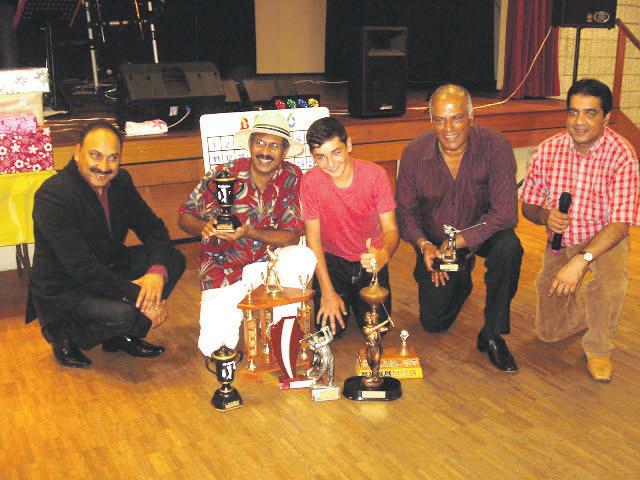


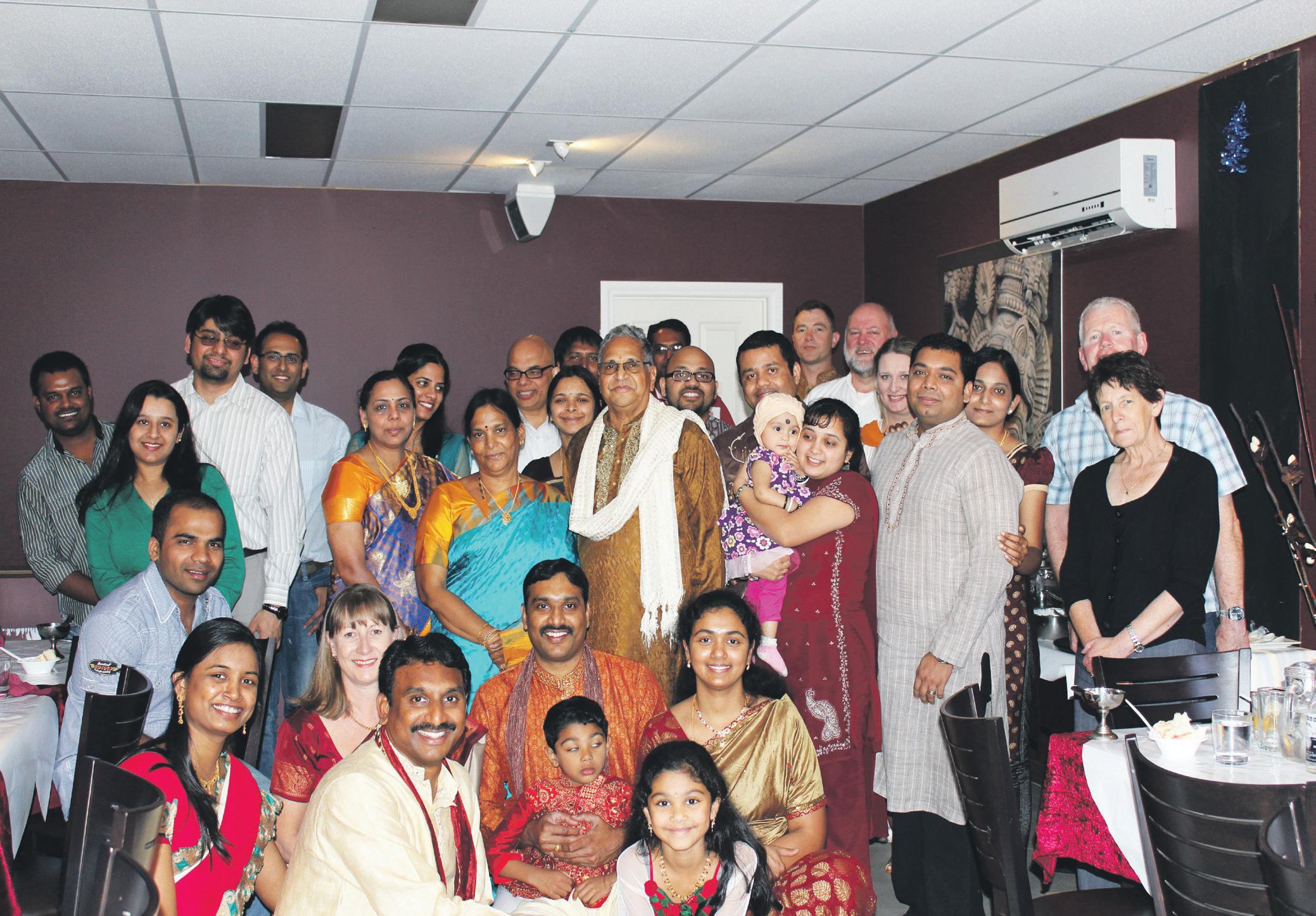
18 MARCH (1) 2013 www.indianlink.com.au Golf Awards at the Valentine’s Day Social.
a fairy party for five-year-old Siona Trivedi, seen here with big sis
It’s
Vidushi
Do you have a photo for this page? Email it to info@indianlink.com.au
Ritesh Verma (2nd from right) celebrates his 29th birthday with friends
welcome
Kapil and Neeta Shah of Hornsby
baby Hridha
Visiting from India, Dara and Sailaja Nehru (centre) get together with friends and family to celebrate their 40th wedding anniversary at the Melbourne home of their son Visal.

MARCH (1) 2013 19 NATIONAL EDITION
Throw for gold
Despite financial hardships a determined athlete doggedly pursues his sporting dream for glory
BY PREETI JABBAL
In the battle that goes on through life I ask but a field that is fair, A chance that is equal with all in the strife, A courage to strive and to dare.
This sportsman’s prayer rang like a litany in the mind of Ravinder Singh Khaira as he prepared to compete for the Victorian Open and AWD Track and Field Championship recently. The event was the Men’s Javelin Throw and Ravinder had reached the finals. The Lakeside Stadium in Albert Park had turned into his personal battlefield, and he was in it to win.
Hours of gruelling training sessions and determination came to the fore and Ravinder won the gold, coming first with a throw of 70.86m.
“It was not my personal best,” remarked Ravinder as he described the event later. “I have thrown at 74.68m in official competitions, but my aim is to reach 77m and more”.
If Ravinder throws at 77m or more, the Victorian Institute of Sports will pay for his flights and accommodation to attend competitions around Australia. At the moment he is mostly selffunded and has had to forego certain competitions due to affordability.
Ravinder came to Australia from Patiala, Punjab in 2009 as a student to do an Automotive Diploma. He currently relies on his parents in India and his weekend taxi job in Melbourne to make ends meet and to finance his own training.

“It is not easy for me to pay for coaching sessions, club membership, expensive equipment, dietician, physio and massages on a regular basis, but I have somehow managed thanks to generous friends and supportive parents, and most importantly, through the sheer will to continue and aim for a world championship,” claims Ravinder.
Twice winner of the Victorian Javelin Throw championship, Ravinder’s throw of 72.42m in the javelin event got him to 3rd place in the 2013 Hunter Track Classic in February 2013.
Ravinder has also qualified to attend the Australian Athletics Tour: Qantas Melbourne World Challenge to be held on April 6 at Lakeside Stadium, Melbourne; and the 91st Australian Athletics Championships & World Championship selection trials to be held on April 11 at Sydney Olympic Park Athletics Centre, Sydney. This event is the culmination of the Australian domestic season, and more than 600 athletes are expected to represent their state or territory at this championship. In 2013, the meet will also serve as the official Selection Trials for the Australian Flame team to the 2013 IAAF World Championships in Moscow, Russia.
Ravinder is also preparing for the Asian Track and Field championship to be held in India in July 2013.

Says Ravinder’s ex-coach Gus Puopolo, “Ravinder has talent and potential. He now needs to turn his talent to distance.”
His current coach Iain Simmons agrees. “I have known Ravinder for a few years now, but I’ve only been coaching him for just over a year since I retired from javelin throwing. I believe Ravinder has the potential to at least be an Olympic finalist, as some of his physical testing is at a similar level to the world’s best javelin throwers,” he says.
He adds, “We have a goal of qualifying for this year’s world championships in Russia. To be able to reach these goals, Ravinder has to train full time –that involves 12-14 sessions per week. This makes it difficult to support himself with the high cost of being an elite athlete, with continuous costs including medical, training, coaching, dietary and travel that add up well into thousands of dollars. He does this while working as a taxi driver. I admire his dedication to his sport and his drive to compete for his country, though this is not the best training environment for an elite athlete”.
In 2007-2008 prior to coming to Australia, Ravinder used to participate in javelin events for the National Institute Of Sports in Patiala. Between 2003-2006 he also competed on state and national levels in volleyball. He took up javelin throw around that time, after getting disgruntled with team sports and the associated politics. Ravinder always enjoyed tinkering around in his house and he decided to come to Australia to complete his diploma in Automotive.

“Australia is a country where people with sports talent aim for the best. Majority of the sportspeople here aim to be part of the world championships, Olympics or Commonwealth
Games. They start by aiming very high and when they put in the effort they definitely get results. I admire this mental strength and I feel motivated by it,” says this driven young man.
Ravinder’s story is inspiring as he strives to compete and win against athletes who are far better supported than him through sponsorship packages and monetary backing. He puts in nearly 25 hours a week in training and physical fitness, which does not leave much time or energy to earn a living.
His parents who are both teachers by profession, are very supportive and help him as much as possible.
“However, it is not much when you convert Indian money to Australian dollars,” says Ravinder practically. “I understand that financial stability is important. My friends keep chastising me for relying on my parents and not taking up a full time job; however I am convinced that this is the prime of my sporting career and I should focus on my sport completely above all other things. I am willing to put in the hard yards and qualify for the world championships”.
“I will be representing Australia as well as the Indian and Sikh communities,” he concludes with hope.
Twice winner of the Victorian Javelin Throw championship, Ravinder’s throw of 72.42m in the javelin event got him to 3rd place in the 2013 Hunter Track Classic in February 2013
20 MARCH (1) 2013 www.indianlink.com.au
yO u TH
“my friends keep chastising me for relying on my parents and not taking up a full time job; however I am convinced that this is the prime of my sporting career and I should focus on my sport completely above all other things”
Ravinder Singh Khaira
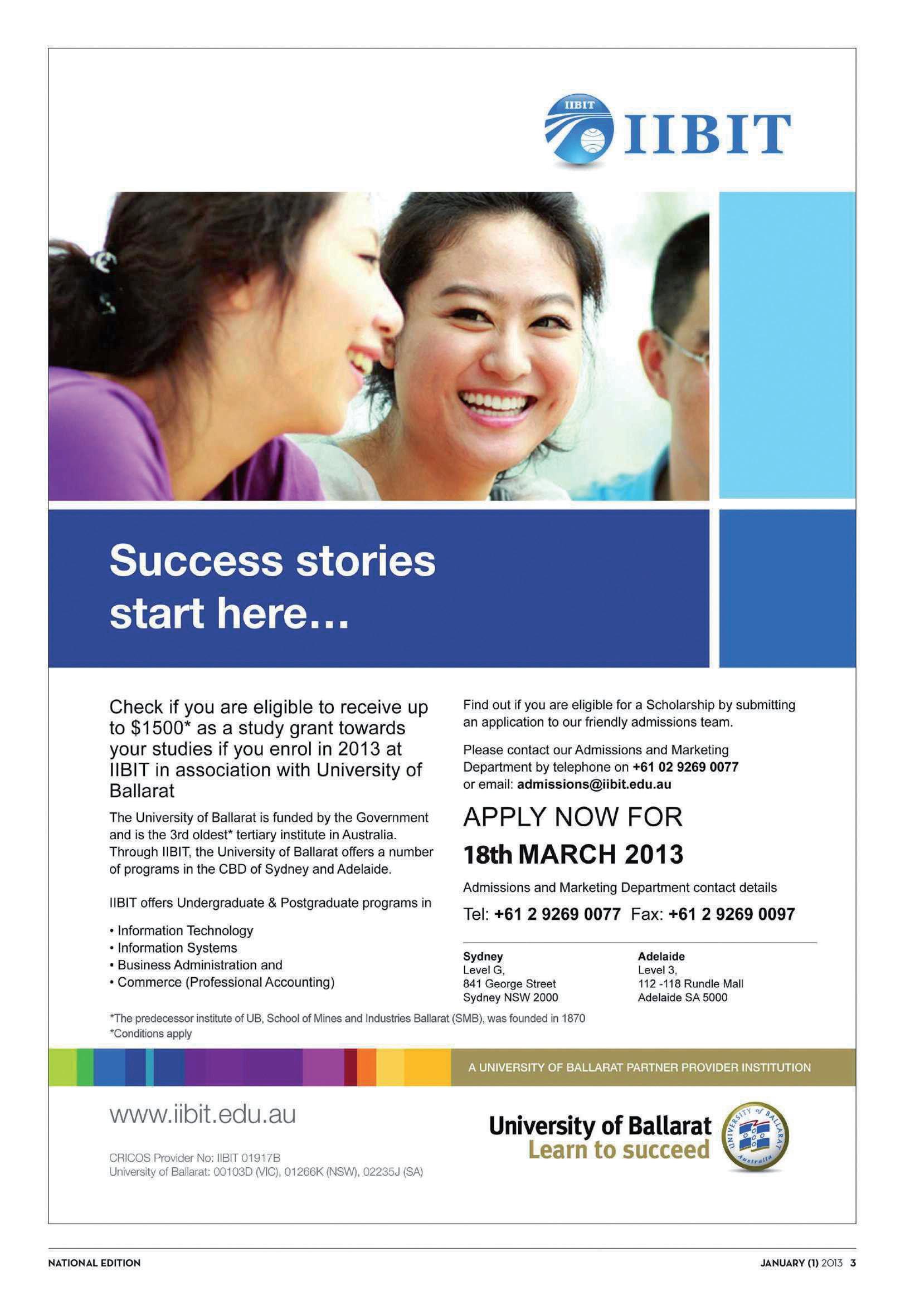
A great Indian epic in dance
The Ramayana holds its place as one of the greatest Indian epics in history, depicting beautifully the devotion of a king, a son, a brother, a wife and the duties of a man in the world. Lord Vishnu in the incarnation of a man showed the world the path to ultimate success and peace in life. This most respected grantha of the Hindus, was written by Rishi Valmiki in Sanskrit, but Goswami Tulsidas gave this epic its most popular form through the Ramacharitmanas. This is what has made the Ramayana everyone’s favourite epic, regardless of whether they are rich or poor, educated or uneducated, man or woman, young or old.
Shri Raghavan Nair and his daughter Poornima Sharma, through the Indian Dance Centre, present the epic story of Lord Rama in the form of a magical dance drama. Their production will showcase all the major events in the Ramayana from Lord Rama’s birth to the destruction of evil Ravana. This beautiful 2.5 hour production will be the first of its kind to be staged in Sydney.
The dance form, presented in Uday Shanker style, will feature over 45 dancers from different cultural backgrounds.


Shri Raghavan Nair and his wife Nisha Nair are founders of the Indian Dance Centre in Sydney and have been running the centre with their daughter Poornima Sharma for the last 26 years. The dance school which teaches Kuchipudi, Semi Classical, Folk, Bollywood, Contemporary and Dance drama formats, holds classes in Ashfield Public School. They now have a new location in Liverpool.
Indian Dance Centre is the proud winner of the South East Asian cultural awards for 2007, 2009, 2010. In 2012 Mr Nair received a lifetime achievement award from the Hindu Council of Australia.
RAMAYANA will take place on 23rd March 2013 in MARANA AUDITORIUM, Hurstville NSW at 7.30pm. Tickets can be purchased by calling Poornima Sharma on 0413 207 414 or emailing poornima.sharma@ indiandancecentre.com.au
22 MARCH (1) 2013 www.indianlink.com.au
advertorial
Homoeopathy can treat various kind of acute or chronic disorder in all age groups including. To name a few acne, eczema, psoriasis, hair fall, IBS (Irritable Bowel Syndrome), flatulence, indigestion, heart burn, constipation, piles, Sinus problems, adenoids, tonsillitis, hay fever, Allergic problems, cough and cold, asthma, backache, stiffness, sciatica, premenstrual syndrome, menopausal syndrome and other female problems, anxiety, depression, memory and concentration issues, sleep disorders, headaches (e.g. migraine), kidney stones and infections, thyroid disorders and more. Consultant




MARCH (1) 2013 23 NATIONAL EDITION Healer SHABAD GURBANI DEVOTIONAL C.D. FOR C.D.S SMS 0413 975 336 SACHKHANDKIRTAN@GMAIL.COM DOOKH NIWARAN NARAYENE A select number of corporate stores available for sale VictoriA: • Langwarrin • Mornington • Vermont • Doncaster East • Brunswick • Frankston • Wodonga • Yeppoon • Gladstone • Hervey Bay • North Lakes • Aspley • Ipswich GoLD Coast: • Helensvale • Burleigh Heads Do you HaVE aCCEss to $60k as a DEposIt*. IF so you CouLD BE part oF tHIs FLaGsHIp pIzza FraNCHIsE. tHIs oFFEr Is opEN For a LIMItED tIME For VICtorIa oNLy. QuEENsLaND: Gautam Jain 0404 077 079 DEposIttakEN DEposIttakEN DEposIttakEN A HOMOEOpATHY CENTRE IN THE HEART OF SYDNEY. A safe, gentle and natural solution to your health problems.
can Homoeopathy treat? Sarita Kalia Adv Dip - Sydney M: 0414 860 517 Kanchan Saxena B.H.M.S. (Gold Medalist) M: 0431 818 552 Jaya Chander Madhurakavi B.H.M.S. M: 0430 322
Contact Consultant Homoeopaths for Consultation or medicines.
What
757
Homoeopaths: www.homoeopathyplus.com.au 1/15 (First Floor), Station Street Wentworthville NSW 2145 Shonit Danwer D.H.M.S. M: 0412 191 444
There Is A LOT Of Money In Coffee!
New HEaLtHY Coffee Concept Launching in Australia


Mr Eric Bamba Lee

a n international SP iritual healer and C


I can solve all your spiritual problems in a few days time. I can specialise in bringing back love ones, using the most powerful KAHTEEM spirits from HAITI.
I can help bring luck in your life, luck regarding money and fame. I can help give you the most powerful protection, protecting you and your family for life from spirit, spells, and your enemies. With the power KAHTEEM, will also help you to get back your lost happiness, and unknown spiritual problems will all be solved, all your dreams will come true. Your pain is my concern; I will do my best not to disappoint you. All the work is private and confidential
Please do not hesitate to call Mr eriC BaMBa lee on 0406826302 or 0448 852 041 from Monday to Saturday 9:25 am to 7:25 pm by appointment only.
24 MARCH (1) 2013 www.indianlink.com.au SHASHI HAIR & BEAUTY SALON AND BODY PIERCING CENTRE We use all dermalogica products Mobile: 0411 140 963 Blacktown Shop 2073, Level 2 Westpoint Shopping Centre Tel: 9679 9288 Mt Druitt Shop 222 Westfield Shopping Centre Tel: 9675 1200 St Marys Shop 26 St Mar ys Village Tel: 9833 3334 Merr ylands Shop 1014 Stockland Merrylands Tel: 9682 2002 NOW OPEN IN STOCKLAND MERRYLANDS • Threading • Facials • Waxing • Tinting • Body Massage • Acrylic Nails • Ear, Nose And Body Piercing • Ipl-Permanent Hair Reduction • Weight Loss • Body Treatments • Micro-Dermabrasion • Non-Surgical Face Lift • Painless Skin Tag Removal • Massage • Haircut, Perming, Keratin Treatment, Hair Colouring, Foils, Tint Regrowth, Full Colour, Chemical Straightening, Up-styles Yes we do Shahnaz Facials Hair Ser vices Gift Vouchers Available
Already established in 26 countries Start your own Healthy Gourmet Coffee Business from Home. $10,000 p/m possible in just 6 months. Call: (02) 8072 6266 NOW For additional information.
lairvoyant with P ower of K ahtee M


MARCH (1) 2013 25 NATIONAL EDITION
A special guest at Ashbury Public School
Ela Gandhi talks to primary school kids about her grandfather’s work

As the primary school students sang the number Hum honge kamyab (We shall overcome), an emotional Ela Gandhi related how she sang this very song to herself when she was incarcerated in a South African prison during the days of the antiApartheid struggle.
The particular song was a favourite of her illustrious grandfather Mahatma Gandhi, and became an anthem of the movement he led for India’s independence from British occupation.
The students at Sydney’s Ashbury Public School welcomed peace activist Ela Gandhi at a special school assembly, as part of a program on Indian studies. Called ‘India Calling’, this innovative educational program is aimed at developing an understanding of India and its culture among primary school children. With five other schools in the area, 520 students in Years 3 and 4 celebrate India’s festivals and learn the Hindi language, as well as songs and dances from India. The project was launched by the Sydney Region of the NSW Department of Education and Communities in 2008, as part of its ‘Expanding Horizons with Asia’ initiative.




At the assembly, Ms Gandhi interacted with the students, the blue of her sari in sync with the blue of their uniforms. She spoke to them about her grandfather, describing in particular his iconic Dandi Salt March. (The students learned that with this 24-day walk on which thousands of people joined him, Gandhi triggered off the peaceful Civil Disobedience Movement that ultimately ended the British colonization of India). The other participating schools joined in via video-conferencing.
Ms Gandhi also watched a special presentation in which a young student read out a peace poem. This was highlighted by a Powerpoint presentation made up of illustrations created by the students. And of course, this was a perfect opportunity to present that Jai Ho dance number yet again!
As well, Ms Gandhi planted a tree in the school’s Peace Garden.

Earlier on, she was welcomed in true Indian tradition by Ashbury kids, who marked her forehead with a tikka

Relieving Principal Mrs Sally D’Arrigo said later, “It was a beautiful day. The students got to see Ela Gandhi’s peaceful nature first hand and learned of the value of non-violence”.
Mala Mehta, founder of
the IABBV Hindi School in Thornleigh who helped devise the India Calling program, also attended the event and was thrilled with how well it went. “I was quite overwhelmed, not only with the fact that the kids responded so well, but also to note that the program has come so far as to be able to host a personality of the stature of Ela Gandhi,” she said.
26 MARCH (1) 2013 www.indianlink.com.au
SP e C ial re P ort
Photos courtesy Mala Mehta
Ms Gandhi planted a tree in the school’s Peace Garden.
Modernity and the Mahatma
Gandhiji’s granddaughter offers relevant insights into his teachings from a current day perspective
BY HASNAIN ZAHEER
As societies the world over grapple with the challenge of a growing culture of violence, Mahatma Gandhi’s legacy reminds us that the values of non-violence, tolerance and peaceful coexistence continue to be pertinent decades after the Indian leader propounded them as a philosophy of life.
This message was brought home to us by none other than the Mahatma’s own grand-daughter Ela Gandhi, who visited Sydney late last month.
“We need to promote proactive programs on non-violence from the very basic levels of the educational process,” Ms Gandhi said, speaking as a guest of the University of New South Wales.

She was delivering a talk entitled ‘Building a culture of non-violence’ as part of the ‘So, What?’ lecture series organised by UNSW’s Faculty of Arts and Social Sciences.
In her thought-provoking lecture to a diverse audience in a packed hall at the university’s John Niland Scientia Building, Ms Gandhi made several powerful points.
“There is a growing culture of violence - structural, domestic, ethnic, religious, racial and many other types of violence arising out of our variety of differences,” she noted. “There are many reasons for its proliferation - inequality, poverty, inadequate justice system, unemployment, access to legal and illegal weapons, conflicts, and breakdown of social and family structures among others”.
To counter this, the most important tool in building a culture of non-violence, Ms Gandhi underlined, is imparting good basic human values and learning to be non-violent, right from early childhood education through to tertiary education. She emphasised the early learning phase, “a time of remarkable physical, cognitive, physical, social and emotional development”, during which these values can be instilled particularly successfully.
“Teaching the art of nonviolent communication is a very important cog in this wheel,” claimed Ms Gandhi. “Good and intensive education in the early childhood phase has lifelong benefits. But it must have good content and should use effective
Gandhi
methods. And, the quality of the educator is the key determinant”.
Referring to Mahatma Gandhi’s education that took place in South Africa, she quoted from Nelson Mandela, who noted famously that India gave South Africa a Mohandas, but received a Mahatma in return. She spoke in detail about the 21 years her grandfather spent in South Africa which had an indelible effect on his personality and his life.
He had 6 major influences in the 1890s, she indicated: learning about the four major religions (Islam, Christianity, Hinduism and Zoroastrianism - Mahatma Gandhi read the Quran, Bible and Bhagvad Gita, and respected all religions); colonialism; racism; unjust and unequal social divide; working out the psychology of the oppressed, and exploitation of the environment by human beings
The Mahatma’s sources of learning were via first-hand experience of discrimination and
thinking about new economic models. He analysed prevailing social views and came with the concept of sarvodaya - good for everyone.

Gandhiji was transformed during this time. This was a journey of learning and self-transformation that led to his lifelong quest for the discovery of truth.
Noting that life is about learning and re-learning, Ela Gandhi was saddened to observe that in the present educational systems, there is more emphasis on skills, and not enough on values. The result is selfishness, impatience, greed, exploitation and other undesirable tendencies. To bring about change, Ms Gandhi recommended that a learning process through which good values can be communicated, should be implemented from early childhood.
In the Q&A session that followed, Ms Gandhi communicated her highly sophisticated Gandhian-inspired views on a range of topics from global terrorism, violence in TV, movies and games to communication via social media.
humiliation, reading literature, and interaction with intellectuals.
In the face of oppression, he realised that he had three choices: meek subjection to oppression; returning home to India; and staying and responding with strong objection.
Gandhiji, of course, stayed and opposed. He wrote extensively. In 1906, he published Satyagrah; in 1909, he wrote his seminal book In Swaraj; and then started The Indian Opinion newspaper in four languages. He moved to the Phoenix settlement where he started his experiments with truth. He learned, Ms Gandhi listed, punctuality and time management, to develop his body, mind and soul; to control his self; grow his own food; live with people of all races; critical thinking based on knowledge; meaning of liberation and swaraj; equality of women, and importance indigenous knowledge systems.
Mahatma Gandhi developed
A renowned Gandhian, Ela Gandhi is Chair of the Gandhi Development Trust, and a Padma Bhushan awardee (2007). She manages the Phoenix Farms in South Africa where Mahatma Gandhi spent several years, and which is now a heritage site. She has participated in the antiapartheid movement, was jailed in 1983 and has been a member of the South African parliament representing Nelson Mandela’s African National Congress (ANC).
My own introduction to the Gandhian thought came not via the Mahatma’s books but through Pandit Nehru’s The Discovery of India. India’s first prime minister was a close friend and disciple of Mahatma Gandhi and in his books and writing, he presents a great insight to his transformation from Mohandas to Mahatma. This is an excellent medium for getting a thorough introduction to India and its Father of the Nation, Mahatma Gandhi.
Ms Gandhi also inaugurated the International Centre of Nonviolence in Sydney as part of her visit and agrreed to be its patron.Gambhir Watts, President of Bharatiya Vidya Bhavan Australia, announced its opening as a partnership of Gandhi Development Trust and BVB Australia.
Thanks to William Balfour of UNSW in helping with the access to material for this article
MARCH (1) 2013 27 NATIONAL EDITION
special report
Photo: Michael Anderson
“There is a growing culture of violence - structural, domestic, ethnic, religious, racial and many other types of violence arising out of our variety of differences”
Ela Gandhi
Ela
To bring about change, Ms Gandhi recommended that a learning process through which good values can be communicated, should be implemented from early childhood





28 MARCH (1) 2013 www.indianlink.com.au 09 8774 6160 Hallam Wantirna 03 9800 3988
All set for big school
Toilet partners
My school is great! On my first day, my friend Meisha was my toilet partner. When we had to go to the toilet, we would go together. After school, I went to the school park with my mum and sister because I wasn’t tired. The next day also I went to the park after school and showed my friend who my mum was. I like school, its lots of fun!
Marcus Miranda Epping Heights Public School Carlingford, NSW


Too nosey I like my Kindy, it’s fun and I’ve made some friends. But when I first came to the class, I didn’t know anyone’s names. I called one girl ‘Nosey’ because her nose was always running. When I told my mum, she found that girl because of her nose. Now that I know the names of my friends, I don’t have to call them anything else. But the Nosey girl is not my friend, because her nose still runs.
Maya JhaveriParadise Kindergarten/East Marsden Public School Adelaide
Made a friend
I’m 5 and a big girl because I’m going to school now. On my first day of school
I learned many things like how to drink from the bubbler. I also made a new friend, but I didn’t know her name then. I know it now, and she is still my friend. On my first day, I told my mum what I wanted for lunch and she packed it. I wore my uniform, had my bag packed and we went to school. It was exciting and I liked it.
 Sai Hasini Madukuri Darcy Road Public School, Wentworthville, NSW
Sai Hasini Madukuri Darcy Road Public School, Wentworthville, NSW
myPlayingwith friends
I like my school, I’ve made lots and lots of new friends. I play with them, so now I don’t have to only play with my big sister. I get tired and wish mum would park the car closer so I wouldn’t have to walk so far when school’s over, but it’s still a lot of fun!
Reece Gaete John Palmer Public School KellyvilleRidge
Biggirlnow

I love school! I have been to school for only a few days, but I had lots of practice at my preschool. On my first day, I woke up early and put on my uniform, I told my mum what I wanted in my lunchbox and got my bag ready. I’m a big girl now, and am excited to go to school.
 Akansha Harekoppa Darcy Road Public SchoolWentworthville, NSW
Akansha Harekoppa Darcy Road Public SchoolWentworthville, NSW



Fun, not ABC I liked my first day at school. My mum and dad told me that I would learn ABC and 1-2-3 at school, but I just played and had fun. I told my mum that I didn’t learn ABC and she just laughed. My dad asked what I had learned and I said nothing. But then he said that if I didn’t learn anything, I don’t need to go to school. So I told him what I did because I want to go to school. He can be so bossy!
Siona TrivediRedeemer Baptist School North Parramatta, NSW
K indyK id S





30 MARCH (1) 2013 www.indianlink.com.au pacific tutoring www.pacifictutoring.org.au 1 Gladstone Road Castle Hill NSW How did your child perform at NAPLAN? What are you planning to do about it? *Scholarship programs are available for students and families with financial difficulties!!! Australian Curriculum Assessment And Reporting Authority (ACARA) “The National Assessment Program – Literacy and Numeracy (NAPLAN) is an annual assessment for students in Years 3, 5, 7 and 9.”NAPLAN tests the sorts of skills that are essential for every child to progress through school and life, such as reading, writing, spelling and numeracy.” Is the education of your child important to you? Of course it is !!! (*conditions apply) While Tutor Our Kids Association charges for their tuition services so they can provide the capital they need to purchase the resources for all students, they also offer scholarship programs for those students and families with financial difficulties. Tutor Our Kids Association scholarship program provides free tuition to students who come from families with low income to provide a fair tuition system. Fees for classes start from $8.90 per student Kids from 3 years old Classes from early morning to evening tel: 9744 7055 www.familySelfdefence.com.au Kickboxing, Jiu-jitsu, hanmudo 1 GlAdSToNE Rd CASTlE HIll fighter workout, Gym we improve Confidence, focus, discipline, fitness, Self defence, Perseverance. one MoneyMonth Guarantee*BackFree Uniform/Gloves* Conditions Apply* 2/85 VICToRIA Rd PARRAMATTA Cnr Victoria Rd & Macarthur St, Opposite 7Eleven 14/118 QuEENS Rd fIVE doCk Cnr Victoria Rd & William St, Opposite Five Dock Leisure
free Call auStralia wide 1800 070 921 Sydney * MelBourne * BriSBane * adelaide * Perth


MARCH (1) 2013 31 NATIONAL EDITION
A child, dressed as Lord Shiva, plays with sand on the banks of the Sangam in Allahabad during the Maha Kumbh. The Kumbh Mela, which runs from January till March takes place every 12 years in Allahabad.

Serious lapses in $9.5 billion farm loan waiver scheme: CAG
The government has again come under attack for a corruption scandal -- this time related to the 2008 Rs.52,000 crore ($9.5 billion) farm loan waiver scheme, in which the official auditor has pointed out serious lapses and malpractices.
In a report tabled in parliament on the “Implementation of Agricultural Debt Waiver and Debt Relief Scheme, 2008”, the Comptroller and Auditor General (CAG) said there were irregularities in at least one in five cases.
Thousands of ineligible persons were given the benefits while deserving ones were denied, CAG said in the report.
“Overall, the performance audit revealed that in 20,216 or 22.32 percent of the 90,576 cases test checked in audit, there were lapses/errors which raised serious concerns about the implementation of the scheme,” the CAG said.
Prime Minister Manmohan Singh’s government had announced a debt waiver for farmers across the country in 2008, a move that analysts say helped the government win the 2009 general election.
“Farmers who had taken loan for nonagricultural purposes or whose loans did not meet eligibility conditions, were given benefits under the scheme,” the CAG said.
The scheme was originally estimated to benefit 3.69 crore marginal and small farmers and 60 lakh other farmers.
Over the last four financial years, the government has waived more than Rs.52,000 crore in loans related to approximately 3.45 crore small, marginal and other farmers.
“It was found that out of the 9,334 accounts test checked in audit across nine states, 1,257 accounts, or 13.46 percent were such who were found to be eligible for benefit of Rs.3.58 crore under the scheme, but were not considered by the lending institutions while preparing the list of eligible beneficiaries,” the government’s auditor said.
Terming the incident a big “scam”, the main opposition Bharatiya Janata Party (BJP) demanded a Central Bureau of
Investigation (CBI) inquiry to unearth the real extent irregularities.
“CAG has found out that 13 percent eligible farmers were not considered by lending institutions. Also 8.5 percent ineligible beneficiaries got benefits,” said BJP spokesperson Prakash Javadekar.
Hyderabad blasts: Court warrants against Riyaz Bhatkal
A Delhi court issued non-bailable warrants against banned terror outfit Indian Mujahideen founder Riyaz Bhatkal and nine other alleged operatives in the Feb 21 Hyderabad twin blasts.
A National Investigation Agency (NIA) special court, during an in-chamber hearing, issued the warrants against Riyaz Bhatkal, suspected to be based in Pakistan, and nine other terror group operatives: Iqbal Bhatkal, Mohsim Chaudhary, Amir Reza Khan, Shahnawaz Alam, Asadullah Akhtar, Ariz Khan, Mohd. Khalid, Mirza Shadaab Beg and Mohd. Sajid.
District Judge I.S. Mehta also sent two alleged IM operatives Syed Maqbool and Imran Khan back to judicial custody till March 13, after expiry of their five-day NIA custody.
The NIA questioned the two over the Hyderabad twin blasts.
The agency told the court that Maqbool and Khan were taken to Hyderabad and they revealed some important facts about the blasts, court sources said.
Maqbool and Khan had in July 2012 surveyed Hyderabad’s Dilsukhnagar, where the Feb 21 blasts took place, the NIA said.
The NIA told the court that the conspiracy behind the Hyderabad blasts was hatched by IM modules and they also moved an application for issuing production warrant against alleged IM operative Obaid-ur-Rehman, currently lodged in a Bangalore jail.
Allowing the application of NIA, the court issued production warrant against Rehman. The Hyderabad twin blasts, that killed 16 people and injured 117, were carried out on the instructions of Riyaz Bhatkal, according to the NIA.
A democratic, secular Bangladesh in India’s interest: President
President Pranab Mukherjee said a “democratic, secular and progressive” Bangladesh was in India’s interest and India had conveyed the need to maintain communal peace and harmony at a time the neighbouring country is rocked by clashes that has seen over 70 deaths.
“A democratic, secular and progressive Bangladesh is clearly in India’s interest,” the president said in a statement on his way back from his three-day maiden visit to Bangladesh.
“In this context, we conveyed to all our interlocutors the need for an inclusive political process; and the maintenance of communal peace and harmony.”
He said India was hopeful that internal political differences in Bangladesh can be resolved through dialogue “and that the rights of all communities would be fully respected”.
Mukherjee was referring to the clashes in Bangladesh between the Jamaat-e-Islami and the authorities recently that has left over 70 people dead. The Jamaat, a key ally of the opposition Bangladesh National Party, called a hartal or strike March 3 and 4, during the Indian president’s state visit.
Earlier, Bangladesh Foreign Minister Dipu Moni had compared the violence unleashed by the Jamaat to that by proPakistani elements in 1971. She had said the Islamists were attacking temples and burning the homes of minorities in Bangladesh.
Mukherjee said he was returning from Bangladesh “with the hope and confidence that India and Bangladesh can together build a better future for our people, and that our relations can serve as an example for the rest of South Asia”.
“My visit has served to reinforce the special importance that the government and people of India attach to developing the best possible relations with an important and large neighbour like Bangladesh.
“We believe that a strong, stable and rapidly developing Bangladesh is in the interest of not only its people but in the
interest of the entire region. I, therefore, assured the government and people of Bangladesh that India will be a willing, longterm development partner,” he said.
Mukherjee said he was “impressed by the vibrancy” of its people.
“Like India, they have a large population of youth. They are committed to democracy, tolerance, an inclusive social order, free media and building a modern and progressive state,” he said.
“They seek to consolidate the institutes of democracy and keep alive the spirit of their liberation struggle. We wish them well in this great endeavour,” he added.
He also stressed on the need to enhance greater people to people exchanges.
“I made it clear that we wish to grow together with Bangladesh because our destinies are interlinked. Apart from bilateral cooperation, we are now preparing to expand our cooperation at the subregional level. This holds great promise for the security, growth and connectivity that can transform the entire region,” he added.
US honours Indian as exchange alumni
India’s Shubhalaxmi Vaylure has been selected by US State Department as International Exchange Alumni Member for March for her dedication to building greater environmental awareness in India.
Dr Shubhalaxmi’s will be recognized on the International Exchange Alumni website, the Bureau of Educational and Cultural Affairs’ official website for the more than one million Department-sponsored exchange alumni worldwide.
Shubhalaxmi first came to the US in 2003 as part of the Fulbright IndoAmerican Environmental Leadership Programme which took her to the University of Montana to study educational nature centres, the State Department announcement said.
Upon returning from this programme, she drew inspiration from her Fulbright Programme as she implemented innovative educational Programmes at the Mumbai Conservation Education Centre.
Shubhalaxmi went on to study non-profit management at Boston University through the Hubert H. Humphrey Programme. This experience enabled her to bring her environmental advocacy to a new level.
Returning from the Humphrey Programme, she developed online courses in natural history and worked in the organization development sector of the Bombay Natural History Society where she conducted staff training workshops and boosted fundraising and marketing efforts to benefit the Centre.
In 2012, Dr. Shubhalaxmi and a team of her alumni peers won support from the State Department’s Bureau of Educational and Cultural Affairs Alumni Engagement Innovation Fund to provide management trainings for professionals from Indian environmental NGOs. The team has already trained nearly 150 individuals.
Shubhalaxmi Vaylure loves nature, according to her official biography. On her Facebook page, her “dream house” overlooks a lush, marshy, nature scene. “It was in my childhood that I got the nature bug,” she said. “I spent my growing years surrounded by trees and bees. Science was my favourite subject.”
32 MARCH (1) 2013 www.indianlink.com.au indian newS
Photo: AP
Indian-origin science writer wins British Physics journalism prize
Anil Ananthaswamy, a London based Indian origin writer, has won the inaugural Physics Journalism Prize sponsored by the Institute of Physics (IOP) and the Science and Technology Facilities Council (STFC).
The prize is designed to inspire the next generation of physicists by encouraging journalists to grapple with often complex topics and help spread excitement about the subject, according to an IOP release forwarded by the American Astronomical Society.
Ananthaswamy, a consultant at New Scientist Magazine and author of The Edge of Physics, has won the prize for his article Hip Hip Array, which focuses on the Square Kilometre Array, an international project to design and build the largest radio telescope ever conceived.
“Anil Ananthaswamy is being awarded the prize for writing a feature which brings one of the world’s most exciting astronomical endeavors to life -- the Square Kilometre Array,” said IOP President Sir Peter Knight.
The Physics Journalism Award offers the prize of an expenses paid trip to Japan, to visit world-leading facilities carrying out research at the frontiers of physics.
On winning, Ananthaswamy commented, “Writing about physics, especially about the work being done in remote, difficult and sometimes hostile environments, is a special pleasure. Winning an award for doing what I love to do is just icing on the cake. I truly appreciate the recognition.”
Mark Henderson, Head of Communications at the Wellcome Trust and former Science Editor at The Times, said, “Anil Ananthaswamy has an eye for illustrative detail of which the best travel writers would be proud.”
Kirsten Bodley, Chief Executive of STEMNET, said, “The winning article on the competition for the Square Kilometre Array will be particularly inspirational to young people, offering them an opportunity to see how fascinating contemporary physics research can be.”
Commenting on the winner’s choice of topic, Terry O’Connor, Head of Communications at STFC, added, “The Square Kilometre Array will open new avenues of research, and delve further back into the formation of the universe.”
A million-dollar prize for Delhi slum education project
A “hole in the wall” experiment in a Delhi slum, demonstrating how children collectively can teach themselves complex issues, has won educator Sugata Mitra the first one million dollar 2013 TED Prize.
Mitra, an education technology professor at Newcastle University in the United Kingdom, said he will use the prize, awarded by TED, an annual global ideas conference, to launch a global initiative for self-directed learning that builds on his discovery.
“My wish is to help design the future of learning by supporting children all over the world to tap into their innate sense of wonder and work together,” he said in his acceptance speech Tuesday at the TED 2013 conference in Long Beach, California.
“Help me build the School in the Cloud, a learning lab in India, where children
can embark on intellectual adventures by engaging and connecting with information and mentoring online,” Mitra said outlining his plan to build a child-driven virtual school.
“I also invite you, wherever you are, to create your own miniature child-driven learning environments and share your discoveries,” he said asking the global TED community to make his dream a reality with Self-Organized Learning Environments (SOLEs) in homes, schools, and community programmes worldwide.
The TED Prize is awarded annually to an exceptional individual who receives $1,000,000 and the TED community’s resources and expertise to spark global change.
According to TED, after a series of experiments revealed that groups of children can learn almost anything by themselves, Mitra began his pursuit to inspire children all over the world to get curious and work together.
In 1999, Mitra and his colleagues dug a hole in a wall bordering a slum in Kalkaji in south Delhi, installed an Internet-connected PC, and left it there (with a hidden camera).
Soon, they saw kids from the slum playing with the computer, learning English and searching through a wide variety of websites on science and other topics, and then teaching each other.
Mitra and his colleagues carried out experiments for over 13 years on the nature of self-organized learning, its extent, how it works and the role of adults in encouraging it.
Lara Stein, director of the TED Prize, said Mitra “has not only created a remarkable body of research around selfdirected learning, but he has support from teachers around the world who are tapping into his methodology with great success.”
AIFF happy with positive reaction from corporates
The All India Football Federation (AIFF) was happy with the positive reaction they got from 30 interested corporate groups, who have shown interest in bidding for two new teams for the 2013-14 I-League.
Prominent groups like Hero Motors, Sahara, GMR, Venky’s, Piramal, Dodsal
Group, IL&FS, JSW, and DSK attended the Open House session at the Football House.
AIFF president Praful Patel said it was important for all the clubs to have their own infrastructure.
“Take it from me; this initiative will help all existing clubs find partners. Clubs will fulfill the club licensing criteria which is very essential for development infrastructure and youth development. Every English Premier League club has a ground, which they call their home ground. Here no club has that.
“In Kolkata four teams use the same ground. Now with two new clubs backed by corporate bodies coming up, these issues are expected be sorted out as they will be under the club licensing criteria. All the other existing clubs will follow suit and in the process we can dream of a better League and perhaps one day compare with the best Leagues in the world,” he said.
Patel said that the AIFF will host a similar Open House in Dubai by the end of this month to attract foreign investors from Gulf and Europe. The AIFF has no objections if any of the Indian clubs want to partner an overseas club as a co-branded unit.
I-League chief executive Sunando Dhar told IANS that the AIFF was happy with the response they received from the corporates.
“Today some 30 corporates turned up for the meeting. We are happy with the response that we got from the corporates,” he said.
AIFF vice-president Subrata Dutta told IANS that the corporates were asked to fulfill two criteria - invest in infrastructure for the next five years and that they should bid for any city except from states of Goa and West Bengal.
“We told the corporates that we want clubs from north, northeast, south and western India. We also want them to invest in infrastructure for the next five years,” he said.
Sahara are interested in fielding a team from Lucknow and GMR from Hyderabad. Both Sahara and GMR own Indian Premier League (IPL) franchises in Pune and Delhi, respectively.
Abhijit Sarkar, head of corporate communications of Sahara, was all praise
about the initiative.
“This is an excellent initiative from AIFF. Football needed this to grow and I am glad that it is finally happening. There is market in India for the sport which is so popular here,” he said.
The AIFF is also planning to keep the two new teams safe from relegation for the next two years.
The process of registering new teams is likely to be completed by the end of April. It will help the two new teams to recruit footballers when the transfer window opens up June 9.
Two teams - ONGC and Air India - are likely to be dropped from the I-League after they failed to fulfill the Asian Football Confederation (AFC) club licensing criteria despite repeated reminders.
Kolkata exhibits unknown women freedom fighters

Heroic acts of lesser-known women revolutionaries from 20th century undivided Bengal have come to life through rare photographs at the Women Revolutionaries of Bengal exhibition that began in Kolkata.
“We gathered the photographs based on Intelligence Bureau files. We found mention of 173 women convicted during the early part of the 20th century from undivided Bengal. Out of these, 118 have been displayed at the exhibition,” Simonti Sen, director, West Bengal State Archives, said.
The black and white photographs of the convicts from areas like Faridpur, Chittagong and Kolkata are accompanied with write-ups to elucidate their roles in the freedom struggle.
“All of them were convicted for various reasons during the period from early 1920s to late 1940s. Some were interned, some externed, while some were imprisoned. Most of them were from the eastern part of the then undivided Bengal,” Sen said.
According to Sen, the exhibition will be an enriching experience for students as well as history scholars.
“Text books mention women freedom fighters like Kalpana Datta and Pritilata Waddeddar. But these women are never encountered in text books. Scholars can use them to study further,” said Sen. IANS
MARCH (1) 2013 33 NATIONAL EDITION Photo: IANS INDIAN NEWS
Indian President Pranab Mukherjee is conferred the Liberation War Honour by Bangladesh President M. Zillur Rahman as Bangladesh Prime Minister Sheikh Hasina looks on
looking back
Snapshots from the homeland lead to HSC success for visual arts

student Tanaya Deshpande
BY RAJNI ANANd luTHRA
India, it is said, is an amazing place for photography.


For budding Sydney photographer Tanaya Deshpande, her native India turned out to be a wealth of opportunity – and a cause for HSC success.
The Turramurra youngster picked photography as her
medium for her Year 12 visual art course last year. Tanaya’s major work, entitled Made in India, is based on a series of stunning images from her homeland. It won her a Band 6 result.
“I was looking for the real India, stripped back from the commercial,” Tanaya, who finished her HSC at Pymble Ladies College (PLC) in 2012, told Indian Link

Getting down to the bare basics, the young photographer found beauty in shots of nature, just as much as in those of people.
Poignant photographs of street
kids, the colours of life on streetsides, even moments from the daily routine of life, captured her interest. For sure, you will find hints of the western stereotypes about India – the Taj, elephants, henna tattoos. But this, ultimately, is the beauty of the work: it shows the artist looking at India from the vantage point of a native, as well as that of an outsider.
The striking feature of the composite image is that the individual shots are projected on to the bare backs of human figures.
“My statement is that travel changes you: it leaves a mark on you that stays forever,” Tanaya revealed.
She might as well have been saying that India leaves a stamp on you forever.
The work was presented on 9mm-thick wood, with other photos on thermacol.
It comes as a surprise to learn that Tanaya only took up photography three years ago.
“My uncle is a keen photographer and inspired by him I began to play around with the camera,” said Tanaya.

Her first pieces were based on flowers.
“I wasn’t even going to do visual art as a subject in Year 12,” Tanaya admitted. “It just occurred to me while thinking about my possible subjects that perhaps I should do something creative to get a break from the rigour of other subjects, so I picked it. And then I couldn’t decide between photography and ceramics, both very popular options at my school, and both of which scale well”.
In the end of course, it all
34 MARCH (1) 2013 www.indianlink.com.au artS
at India
worked well for the spunky young girl.
“Not only did I finish with a Band 6 in visual art, it also turned out to be my best subject!” she said.
Today much of Tanaya’s Year 11 and Year 12 work is shown as samples for the benefit of younger students at PLC who are starting off in the subject.
Speaking about her school course in photography, Tanaya said, “In my first year in photography in Year 11, I learned all about the camera and how to use it. A lot of it was new to
me, such as ISO exposure and all the jargon! We also learned how to organise photoshoots and did various experiments such as underwater photography, and then went on to Photoshop as well.”
She continued, “By the end of Year 11, I was hooked. I couldn’t wait to get on to my major work for the HSC. Various project ideas came into my head, especially as my teacher said, ‘think big, the world is your oyster’.”
That year Tanaya travelled to India with her family and came back with about a thousand shots on her camera. She knew then
that those photos would form her final work for the HSC.
“Of course, to pick 6 out of the lot was a challenge,” she said with a laugh. “But my teacher helped me as I sorted through them. As I looked at the work of other artists to get a better perspective, the idea came to be that I could project each of my chosen images on to the bare back of a human figure.”
The end result was nothing short of striking.
The work is certainly a pat on the back for this talented photographer.
But the beauty of the work is that it shows the artist looking at India from the vantage point of a native, as well as that of an outsider
Tanaya travelled to India with her family and came back with about a thousand shots on her camera






MARCH (1) 2013 35 NATIONAL EDITION
Tanaya Deshpande
The Tagore women and a tale of empowerment
The women of the famed literary family from Bengal were harbingers of change in their own right, writes
MADHUSREE CHATTERJEE

At a time when the struggle for a world that is safe for women is in the news, here is a book that is timely, even as it retells history.
Aruna Chakaravarti, a 2004 Commonwealth Writers’ Prize nominee, recalls the contribution of the Tagore women to the modern women’s movement in her new book Jorasanko (Harper Collins India). Jorasanko is the name of the Tagores’ ancestral home.

Jnanadanandini, wife of Satyendranath Tagore, elder brother of poet Rabindranath Tagore and the first Indian to enter the Indian Civil Service in 1863, was the force behind the opening of the zenana (area where women were kept in seclusion) in the traditional elite households of 19th century Bengal.
She was the first woman from a feudal family to accompany her husband to his place of work.

After a one-and-a-half year stint in Bombay, as Mumbai was called, where her husband was posted as assistant collector, Jnanadanandini brought the “Parsi way of wearing the sari” to Bengal.
The sari was earlier wrapped around the bodies of women in a single sheath without pleats or a shoulder drape. But Jnanadanandini wore it the way it is draped today, with pleats around the waist and the fabric gathered into a drape to cover the “breasts and the shoulder”, making the woman look elegant.
The feisty wife of the civil administrator was also the first one to wear the Oriental dress - a Mughal style kurta (shirt) and voluminous pants - to travel.
The light-eyed Jnanadanandini,
Jnanadanandini, wife of Satyendranath Tagore, elder brother of poet Rabindranath Tagore and the first Indian to enter the Indian Civil Service in 1863, was the force behind the opening of the zenana in the traditional elite households of 19th century Bengal.
described as “mealy mouthed” by her mother-in-law, introduced the nuclear family within the very walls of Jorasanko, adopting the western way of life.
Chakravarti’s account reads like an absorbing family soap, and one might be forgiven for forgetting that the work is non-fiction.

The work examines other women in the Tagore household too.
Sarada Sundari, wife of Debendranath Tagore and mother of poet Rabindranath, suffered the throes of seeing family values change. The rather plain woman, who commanded the Tagore household and a dashing
husband, refused to let the “old world conservatism slip by”. A little indolent and lazy, she rebelled against daughter-in-law Jnanadanandini.
Sarada’s sister-in-law Jogmaya was a total contrast to her.
Though second in the hierarchy of women in the household, she was the one who looked after all needs of the family. She proved an excellent mother to not only her own children, but to Sarada’s as well, Chakaravarti holds.
Of Tripura Sundari, who was not exactly renowned for her beauty, the author says condescendingly that she made up for the lack of beauty “with her tireless work of household management ... She had the strength and energy of the barren woman and all her heartache. Though she received a lot of commendation, it failed to satisfy her”.
Digambari, wife of pioneer Dwarakanath, Rabindranath’s grandfather, is painted as stoic. She bore her husband’s absence without complaint, and the force of her character surprised even Brahmin pundits.
Driven by the urge to “atone for her husband’s sins” of moving into a new home from ancestor

Neelmoni Tagore’s abode, for his association with British rulers and for the pleasures he sought in nautch girls, Digambari locked herself in the prayer room.
In contrast, Kadambari Devi, the wife of Jyotirindranath and sister-in-law of poet Rabindranath, was a melancholic and gentle woman with deep sensitivities, refined intellect and an insatiable thirst for knowledge. She was driven to end her life.
“Mrinalini was salt-of-theearth”, the silent force behind husband Rabindranath’s meteoric rise in the literary world.
What the writer perhaps forgets to add is the contribution of the petite former Bollywood actress Sharmila Tagore, the widowed begum of Nawab Mansur Ali Khan Pataudi, and great-grand daughter of Rabindranath Tagore. Sharmila was symbolic of the family’s continued presence in the new popular cultural milieu of cinema in India. And in a strangely karmic way, she was also the family’s tenuous tie to its ancient secular roots, the Pirali Brahmins of Jessore, who were ostracised by their Hindu brethren for allowing their blood brothers to convert to Islam and bringing the two faiths together nearly five centuries ago.
36 MARCH (1) 2013 www.indianlink.com.au ServiceS Offered Business Sponsorship Business set-ups Business Strategies Marketing Strategies Business Seminars And More….. ontact: Hanish – 0410 901 906 – 0450 567 884 BOOKS
Aruna Chakaravarti



MARCH (1) 2013 37 NATIONAL EDITION
Spoiling India’s name
the convicted killers of Rajiv Gandhi. The Chief Minister, opposition leaders and other politicians in Tamil Nadu led demonstrations to commute the capital sentences of the perpetrators. Was the Rajiv Gandhi atrocity any less worthy of capital punishment, compared to the Delhi sexual assault?
President Pranab Mukherjee has issued an ordinance at the recommendation of the Indian Cabinet, which provides more stringent penalties, amongst others, for group assaults on women. It encapsulates the recommendations of the Justice Verma Committee. It returns the issues which have been so overplayed in the media, to the principles of legal processes.
Indians spoiling the name of India has seemingly become an art form. No other comparable country soils its own image so well. Political dramatics have been commonplace in Delhi. The first organised giant mela took place in Delhi when demonstrations by adults (and their children) assembled to hear Anna Hazare proclaim himself the prime speaker against corruption. But corruption exists worldwide, including in Australia and the USA. Such corruption led to the Global Financial Crises.
The Anna Hazare campaign was extremely well organised, down to a large number of persons preparing and distributing food. One wonders from where and from whom the money came. Soon after, a similar campaign much of the same crowd, came to see Swami Ramdev, an exponent of yoga, rant against the Congress-led Indian government.
At that time the now famous horrendous incident took place in Delhi – the medical student gang-raped in a bus from which she was allegedly later thrown out. Her horrific injuries led to her death in a Singapore hospital. There were loud and consistent cries for the alleged perpetrators to be awarded capital punishment.

The crowds gathered in Delhi now had a live incident to show the world. But this time the anti-Congress forces were outwitted.
Sonia Gandhi, the Congress President, took up the agitators cause as did Sheila Dixit, the Congress Chief Minister of Delhi. It was now these two ladies who led the agitation.
With this incident, the agitation then moved to women’s safety. India is not the world’s only place where women are bullied.
What about the Australian commission looking into women being sexually bullied in the armed forces? A newly established commission is also investigating sexual crimes in Australian religious institutions. And similar incidents are reported from Ireland, Canada and Britain.
One may get the idea that in India, its people favour harsh judgements and punishment. But it was only months ago that there was an agitation in Tamil Nadu, similar to the Delhi agitation, to pardon
The Delhi agitation against assaulters of women had morphed into a lynch mob. Lawyers refused to defend the accused. Whilst saying that he appreciates the anger of the people, no less than the august personage of the Chief Justice of India Altamas Kabir has warned that such anger must not mean that the legal processes are bypassed.

“People’s reaction has been that do not send the accused to trial. Hand them over to us, we will deal with them or hang them. But let us not get carried away. A swift trial should not be at the cost of a fair trial,” he warned.

There has already been a lynching incident of a high-profile politician, Bikram Singh Brahma by a mob in Assam. He is the Chairman of the Baksa District Congress Committee and the Congress party’s coordinator of the Bodoland Territorial Council.
A political rival accused Brahma of entering his house early one morning and sexually assaulting a woman. The video footage of the lynching has gone viral. He was thankfully handed over to the police as he could not have defended himself when being assaulted.
When slavery was abolished in the USA in the 19th century and thereafter until 1920, an estimated 3,500 Negroes and 1,300 whites were summarily lynched in America’s southern states. In 1891, eleven Italian migrants were lynched in New Orleans. Such horrendous ‘trials’ continued upto 1968! This led to a wholesale fleeing of Negro communities to the north where they now form a substantial part of the population and enjoy a good degree of political power. Negro emancipation was a triumph for President Lincoln. Creditably, the USA sought to protect human rights through legislative measures. The Dyer AntiLynching Bill in 1922 sought ‘To assure to persons within the jurisdiction of every State the equal protection of the laws, and to punish the crime of lynching....’.
It defined ‘mob or riotous assemblage’ as ‘composed of three or more persons acting in concert for the purpose of depriving any person of his life without authority of law’. Dyer was a Republican and his bill was blocked by Democrats who then dominated the southern states.
Ultimately, the USA passed the Fourteenth Amendment which guarantees the right to due legal process whilst the Eighth Amendment prohibits cruel and unusual punishment.
Legal processes should remain paramount as opposed to mob rule.






38 MARCH (1) 2013 www.indianlink.com.au If you do, you are eligible to attend a free energy efficiency workshop in Hindi Receive a FREE Energy Assessment for your business. This activity received funding from the Department of Climate Change and Energy Efficiency as part of the Energy Efficiency Information Grants Program. or Call: 1800 242 845 register at: www.3eproject.org.au Enrol to find out how you can reduce your BUSINESS energy bills. Workshop details: Date: 18 March 2013 time: 6:00 pM to 8:00pM Venue: Wentworthville Community Centre 2 Lane street Wentworthville Do you own a business in Western Sydney?
o P inion
Indians spoiling the name of India has become an art form. No other comparable country soils its own image so well.
Lynching of offenders by mobs has become their method of meting out justice, while the legal system is being ignored
BY NoEl G dE SouZA
Is higher education a guarantee of success?

While the government and Universities entice students into taking degrees, will added qualifications ensure a better career?
BY ukRIT SABHlok
Not too long ago, Senator Chris Evans announced an injection of $67 million in funds for a partnership between universities, schools and state governments. The rationale was simple: help more Australians achieve their goal of going to University. “A university degree gives Australians a greater chance at getting a high paid and high skilled job,” said the Senator.
The Gillard Government believes that higher education should be encouraged, and says its goal is to reach its target of 40 percent of young Australians holding a bachelor’s degree by 2025. That’s despite experts like Tom Karmel, managing director of the National Centre for Vocational Education Research, indicating that there is a risk greater numbers of people pursuing university degrees won’t get a ‘good return’ from it.
Yet since the government spends millions each year subsidising education and making it easy to attend college, there are even more credentialed individuals than ever before. This naturally makes getting a job after graduating more competitive than say in 1991, when only 8 percent of people aged 15 and over held a tertiary qualification. There is – in economic terms – potentially an oversupply of graduates relative to the number of jobs available.
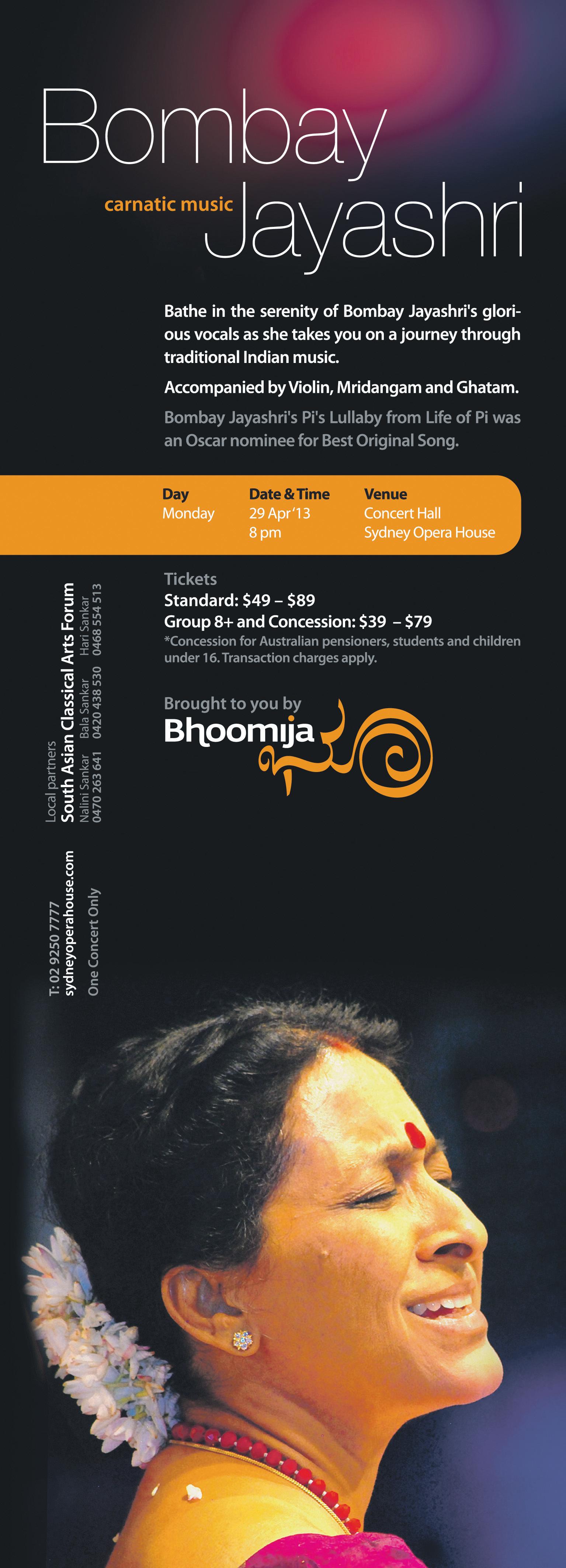
While it’s true that a lot depends on the particular degree you do (the arts degree, forever the butt of jokes, is probably less useful on the job market than a degree in medicine), the debate around university qualifications has raised some valuable questions. Questions like “Is there a better way to structure our university system, a way that doesn’t load students with unnecessary debt and gives them a realistic chance at getting a job down the track?”
Writers like Tony Featherstone, for example, argue that in business, a more flexible mode of education would better serve companies. Instead of the standard 3 year campus-based degree, why not allow students to gain qualifications while doing work experience and receive on-the-job training? Or why not let them enrol in a short-term or part-time course for subjects, as the need arises?
It’s not an exaggeration to say that the current university system promotes conformity at the expense of lateral thinking and creativity. Many of the world’s entrepreneurs – take Bill Gates or Mark Zuckerberg – were college dropouts who made it big despite, or perhaps because of their lack of formal training. University tends to compartmentalise but the real world isn’t always like it is in textbooks, especially if those textbooks are written by state-funded professors whose theories aren’t subject to the discipline of the market.
Chances are, in a free-market without government crutches, specialisations such as ‘gender studies’ aren’t likely to attract many paying students and will be reliant on philanthropic support to survive.
There would also be significantly fewer economists pontificating about policy issues – in centuries past, economics was considered a hobby, not a profession. Only those disciplines that directly relate to providing a good service – in helping produce computers, cars, trains, or curing cancer – would find large numbers of customers willing to pay for the course.
Without government funding of higher education, there would be no taxpayersubsidised pleasant interludes of sex and parties between leaving school and beginning working life (the laid back undergraduate lifestyle). Moreover, practical business skills such as administration and effective communication might enjoy a resurgence.
None of this is to say that the humanities aren’t worth pursuing or that only knowledge that’s commercially valuable is important.
But it’s a reminder to parents, students and anyone at the beginning of their careers that further education isn’t necessarily a guarantee of success or gainful employment in one’s chosen field. The number of cab drivers in New York City who have degrees should be proof of that. As Michael Ellsberg points out in The Education of Millionaires: Everything You Won’t Learn in College About How to Be Successful, even graduates need to learn how to market themselves.
That’s a lesson that Julia Gillard would be wise to consider before subtly instilling the mentality that tertiary education is an end in itself. It’s not the degree that matters – it’s your street-smarts, creativity and diligence that count.
MARCH (1) 2013 39 NATIONAL EDITION
o P inion
It’s not an exaggeration to say that the current university system promotes conformity at the expense of lateral thinking and creativity.
A long way from home
BY kudRAT SINGH
The Road Home is a film that talks about a problem that most Indians living outside India face today, the need to teach our children about their heritage. This film looks at this situation from the child’s point of view and touches upon the sensitive nature of belonging and knowing your place (culturally) in the modern world.
Selected for the 2012 Academy Award “live action short films”, The Road Home is directed and produced by London Film School graduate Rahul Gandotra. The film focuses on the quest for belonging faced by its young protagonist, a British born Indian, who is sent to the Woodstock boarding school in Mussoorie, India, to learn about his roots. The young boy faces the cruel taunts of the other local Indian children who see him as a foreigner, an imposter, and zone in on his vulnerability of being out of place. The boy finds no other option but to run away –which leads him on an incredible coming-of-age journey through the picturesque mountains of north India.

The film, part of Gandotra’s graduating work, was filmed on location in the Himalayas. It won him a jury prize at Palm Springs; was nominated at the British Independent Film Awards; shortlisted for the BAFTAs; and shortlisted for an Oscar in the short film section for 2012.

Rahul Gandotra was drawn

to the project given his own background and experiences as a second-generation migrant. He was born in Belfast, Northern Ireland, and has lived in eight countries since then - all four parts of the UK, Saudi Arabia, India, and the United States.
Gandotra says of the film, “It is semi-autobiographical in that I experienced what Pico (the protagonist in the film) experiences, and went to the boarding school in the film. Before going there, I had been born in Northern Ireland and lived mostly in the UK. So when I arrived at the boarding school at age 9, I insisted I was British, despite being born to Indian
parents. People would ask me, ‘Are you ashamed of your roots?’ not realising that I was defending a feeling I had inside of being raised and brought up in England.”
This experience has led to Gandotra exploring the very interesting and relevant sociologic subject of the “third culture”. He says he discovered this term when researching the subject matter for his short film. He found the term and its explanation by sociologist Ruth Useem, to be rather exact in its description of the “subculture” created by children living within multiple cultures during their developmental years. The term originated when Useem noticed that expats seemed to
form their own subculture that wasn’t quite the foreign culture they were living in, or their own home culture, but a unique blend of the two.
More recently the term describes children who have lived in multiple countries and cultures during their developmental years (from birth to eighteen) so that they are a mix of all the cultures they’ve lived in. These ‘Third Culture Kids’, as they’re called, have less in common with people who are biologically or ethnically similar to them and feel more in common with others who have moved around, even though ethnically and biologically they may drastically differ.
On the back of the success of his short film, Gandotra is currently in the process of producing a feature length film.
With a longer time length, the film hopes to be able to further develop the characters and story. This will most likely see Gandotra further developing the ‘third culture’ theme for the film. No doubt this feature film will cause quite the buzz when it is released in cinemas worldwide.

40 MARCH (1) 2013 www.indianlink.com.au • Established Michel’s store in Sydney CBD. • Great opportunity to walk into high performance business and earn high profit margin from the first day. • Situated in busy CBD street of high rise office buildings, close to Town hall station. • Only 5 days trade, perfect work and life balance!!! • Huge catering side for loyal corporate customers. • High pedestrian traffic of Darling Harbour. • Asking $275,000 Michel’s Patisserie please contact on Serious Buyers Only 0404 261 969 for S ale genuine interests only Indian Restaurant for sale Central location in South West Sydney (7km away from Liverpool) Spacious with 90ppl seating, newly set up with all refurbishing, walk in/walk out, ample parking Phone: 0415 797 243
dia SP ora
“People would ask me, ‘Are you ashamed of your roots?’ not realising that I was defending a feeling I had inside of being raised and brought up in England”
Rahul Gandotra
A critically acclaimed short film addresses issues of identity and belonging faced by children growing up in cultures other than their own
A scene from The Road Home by London-based film-maker Rahul Gandotra
Rahul Gandotra
aCCountin G taxation & i nve S tM ent Cor P oration Pty ltd Public Accountant & Registered tax Agent
W ITH 10 Y EARS OF E x PERIENCE IN TAxATION & Bu SINESS FASTER R EF u ND WITH E LECTRONIC LOD g EMENT We are specialized in:
Preparation of the Individual & small to medium sized Company Tax Return, Partnership, Trust, Superannuation Return, Payroll and BAS. Registration of ABN and Business Name; Set up of Company, Superfund, & Trust. Financial Planning, Tax Investment Property, Mortgage Loan, Audit for Real estate Trust Account, Audit-Solicitor Trust Account, Audit for self-managed superannuation, Travel Agents and all other businesses.
Check out our Website for more Information at www.taxationbusiness.com.au


For Best Professional advice & Service, please contact: Waseem Yousef Suite 3, 55 Main St. Blacktown NSW 2148 P O Box 8575, Blacktown NSW 2148 Ph: (02) 86787438, (02) 86787437 Fax: (02) 86787439 Email: waseemy@taxationbusiness.com.au
international Clairvoyant/SPiritual healer Mr Mane
THE MAN YOu CAN TRuST WITH HIS NATuRAL gOD gIFTED POWER OF SECOND SIgHT.
SuCCESSFuLLY HELPINg DESPERATE PEOPLE FOR THE PASSED 25 YEARS.
Specialist in relationship, Bringing back love one, good luck, Success in business, Sexual difficulties, Court cases, Marriage and family problem, Master of removing all problems
100% guARANTEED-PRIVATE AND CONFIDENTIAL DONT SuFFER IN SILENCE ASTONISHINg RESuLT IN 24HRS
CAll oN 0406 032 635 or 0405 614 938

MARCH (1) 2013 41 NATIONAL EDITION
Gun-ho!

My son was entranced when he realised that he already possessed such an arsenal, shifted to guns
guns of varying shapes, sizes and brands, and they discuss the merits of each. My son was entranced when he realised that he already possessed such an arsenal, and suddenly his interest shifted to guns from origami, somewhat radically! After days of nagging, one rainy day in the school holidays when I was swamped with work, I relented and let the boys unpack a toy gun each. They were enchanted and excited in equal measure, and set up an impressive tower of toilet rolls to use as targets. As I gradually grew into the idea, they played with the toys in the backyard, through the house, and I got used to the familiar click-click-click as the magazine was slid into position prior to taking aim.
But recently, innocently enough, they took their toy guns out on the street to play. We share the street with friendly neighbours and their broods, and suddenly,
after all, I don’t like guns of any kind, real, imaginary or toy, and I don’t want to have anything to do with them. But this attitude came by only in my teens after comprehending how much destruction these weapons were capable of, which horrified and frightened me. Besides wars, stories of gun abuse from the United States have fuelled this disinclination of guns into a robust dislike.
But looking back at my own childhood, I realise that as kids, we played games with guns too. Not the sophisticated weaponry that’s available now that apes the originals to a frightening degree, but idiotic sticks that we carried around yelling ‘Bang, bang, bang!’, or silly plastic toy revolvers that made a sound suspiciously like someone was inopportunely passing wind. They interested and amused us, we enjoyed them and they never really did us any
video games of gore like Halo and Call of Duty that fascinate 11-12 year olds with their brutality? And the biggest torment of all – do I take away the innocence of their gun games by conjuring up visions of bloody mayhem and destruction to stop them from playing with toys to which I have a personal abhorrence? Shouldn’t they be given the opportunity to understand and make up their own minds when they are older?
“It’s just a game to them, and playing with guns in moderation is okay,” said a friend, renowned for her common sense and practicality.
“They see their friends playing with guns, it’s simply the current influence of their peers. Like most other fads, this too will come and go. When some other idiotic toy becomes popular, they’ll forget all about guns!”
I agree with her reasoning.
We’ve been through it all before – the fascination with Ben Ten,
at anyone, and never at adults. Nor can they use the toy guns to threaten or cajole. They play the usual games of running races, yelling competitions or riding their bikes with the other children, but not with toy guns, specially when the littler ones are around. And it hasn’t been difficult for them to accept these terms. They have a good time, as their desire to play with guns is satiated, and they only whinge when the darts disappear into the bushes.
But my innate fear and dislike for guns has barely receded. I will take the occasional pot-shot at a target to let them know that mum’s aim isn’t that bad, but it’s always with a sense of inexplicable apprehension. As their skills in marksmanship are being honed, I won’t object too vociferously. But I will keep my fingers crossed for the next fad to kick in – perhaps knitting, crochet or even pottery… I wish!
42 MARCH (1) 2013 www.indianlink.com.au
Parenting
In fact, I have now begun to explain that guns are weapons of protection for the innocent, that they have to be used responsibly and sensibly
The gifted child
Finding the right schooling and stimulus for children with above average intelligence helps foster their growth
Word reasoning Measures the capacity to understand analogy and for categorical thinking.
BY MOHAN DHALL
There is an increasing understanding in education about the need to cater for all children in their schooling. There is an emerging idea that children are all unique, they learn in different ways and they cognise things at different speeds and levels. Intuitively, all good educators have always known this. From the perspective of parents, mainstream schooling should cater to their child and accommodate all of their strengths, regardless of which domain they occur in. It is common for parents to be told by a pre-school teacher that their child may be ‘gifted’. Typically, an academically gifted child will exhibit the following characteristics:
• Early talker
• Early walker
• Very good memory for detail –either verbal or visual
• Unusual ability to understand jokes – an ability to think laterally and make ‘non-obvious’ connections
• Sleeps very little
• Gravitates towards older children or even adults (particularly if firstborn or only child)
• May have very few friends
Six-year-old Sathya said to his parents, “I don’t want to go to school today”. His parents inquired as to why. He said, “I woke up a number of times last night”. His father replied, “No you didn’t, you woke up once”. Sathya replied, “One is a number”.
The list provided above is not exhaustive, but is a useful earlier identifier of giftedness in children.
So what is ‘gifted’? There are over eighty different definitions in educational writing; however a commonly agreed understanding of the term is: on a standardised intelligence test (IQ test or test of Intelligence Quotient) a child who lies two standard deviations above the norm or average is classified as gifted.
The average score on an IQ test is a score of 100. On such tests the standard deviation equates to 15. Thus a child who scores 115 (or one standard deviation above the norm) is considered mildly gifted, a child who scores 130 (or
two standard deviations above the norm) is classified as gifted and a child who scores 145 (three standard deviations above the norm) is classified as highly gifted.
Tests of intelligence
When a child is assessed as gifted by a pre-school teacher or is deemed precocious by the parents, it is appropriate to have a psychometric test conducted. This is not for the purpose of defining the child by a number, but rather so that the correct schooling choices can be made.
The two main tests used by psychologists are the Weschler Intelligence Scales for Children (WISC) and the Stanford Binet (SB) Test. Of the two, in my experience the preferred test by far is the WISC test, also recommended by the Australian Psychologist Association (APA). Each of these psychometric tests assesses different facets of cognition or thinking which include 15 sub-tests, including verbal and non-verbal (performance) skills. These sub-tests are: Information Range of general knowledge. May reflect cultural background, child’s interest in their environment.
Similarities Verbal abstract reasoning abilities and logical thinking.
Arithmetic Ability to solve basic arithmetic problems /arithmetic reasoning. Also tests short-term auditory recall and ability to concentrate on verbally presented material. May reflect basic computational ability and/or level of schooling.
Vocabulary Extent of verbal fluency, word knowledge and ability to use words and express word meanings. May reflect background, interests and reading habits. Comprehension Social awareness, practical judgement and reasoning.
Level of practical information and understanding of social environment are also indicated.
Digit span Attention, short-term memory and concentration which are pre-requisite skills for recall or oral lessons and for the association of sound and graphic symbols in basic reading skills.
Picture completion Ability to distinguish between essential and non-essential details and to identify familiar images and missing parts from the environment or ‘eye for detail’. This sub-test may reflect concentration or visual acuity.
Coding Immediate visual memory, hand-eye co-ordination, overall psycho-motor ability, manual speed and dexterity, and concentration.
Picture concepts Ability to see things as a whole and the capacity to visually categorise. Reflects visual comprehension of environmental experiences and an idea of the sequence or order of events.
Block design Ability to analyse and manipulate geometric patterns and may reflect visual-motor coordination, spatial orientation and logical reasoning ability.
Matrix reasoning Ability to see spatial relationships, visual-motor organisation and may also reflect learning from trial and error, concentration and persistence. Symbol search Ability to see whether a target symbol appears in a group of symbols or to detect differences in abstract figures.
Visual perception and visual discrimination are assessed as well as speed of processing and concentration.
Letter-number sequencing
Measures attention span, auditory recall (short-term) and processing speed.
Cancellation The capacity to judiciously attend to detail and process visual information at speed.
Implications for schooling

It should be clear from this list that cognition is highly complex and that the sub-tests give insight into different ways of thinking and processing. Reading this list, most parents would recognise the different sorts of cognition. However, they would also understand that accommodating each of these in a mainstream classroom may be actually quite difficult. Assuming a child tests in the gifted range (IQ >130) then several implications arise. The first is the issue of possible early entry, the second is which type of school, and the third is what role parents should take.
Early entry
Early entry is sometimes recommended for highly gifted children and occurs when a child enters mainstream schooling a year earlier than their age peers. Usually when a psychologist suggests this, the school can resist on the ground that the child is ‘socially immature’ or ‘cannot write’. It should be noted that these excuses cannot justify holding a child back from school. The early entry decision must however, be very carefully considered for other reasons including:
• Whether the child’s teacher is trained in gifted education and understands different types of cognition.
• Whether the school has a plan for the transition from Year 6 to Year 7.
• Whether there is a strong sense of communication between teachers in different stages who can track the development and performance of the child and assist to accommodate their academic needs.
• Whether there are any other children who have successfully been through the school having had early entry.
Which type of school?
The short answer to this is the one that takes a psychometric report seriously. In deciding which school a parent should give a copy of the IQ test, complete with its recommendations to the school. The one that responds with suggestions for how the child’s needs could be accommodated is
When a child is assessed as gifted by a pre-school teacher or is deemed precocious by the parents, it is appropriate to have a psychometric test conducted.
probably the best place. Finding that school however can be difficult.
Role of the parents
Sometimes schools cannot accommodate the needs of the gifted child however well-meaning, but the school is the only practical option and thus the child must go to it. In this regard the parents have a special role in ensuring that there is stimulus and interest in learning that occurs outside of the school to complement what the school does. Weekend trips to museums, a visit to Canberra, visits to the zoo and botanical gardens – all of these can engender stimulus and interest in learning. Moreover, joining a club or society with a special interest focus – such as astronomy or science, writing and so forth can also keep a child interested and focused in their learning.
Parents need to be careful of two things however. Not every experience has to be a learning opportunity and further, if a school does not seem to be accommodating the child’s needs then it is probably wise not to discuss this with the child. In the latter case this is because it may lead the child to believe that no institution can teach them and thus they may feel unsettled in their schooling.
In summary, gifted children are children with special needs who need to be in schools that foster growth and learning. Such schools can be ‘discovered’ by seeing their response to psychometric tests. A school with teachers formally trained in gifted education and where the cognitive needs of gifted children are understood would be best.

MARCH (1) 2013 43 NATIONAL EDITION
School
Photo: William Newell

44 MARCH (1) 2013 www.indianlink.com.au

30 years of experience
International renowned spiritual healer / clairvoyant with spiritual powers of my ancestral spirit, I can help you with bringing back loved ones. Family problems, depression, substance abuse, impotency / infertility, court cases, jinx, demonic forces, success in business, exams career, job interview, marriage.
coMPlete Migration SerViceS
(ABN- 91 761 820 052)
liVe in aUStralia, n e W Zealan D, c ana Da
For queries on July’12 changes, Skill Select and Expression of interest call now at 0433 986 780 0421 119 628
i) Advice on Migration pathways
ii) General Skilled Migrationspecialist

iii) Student Visas( new and extension)
iv) State Sponsored Visas / ENS / RSMS / 457
v) Business Migration
vi) Partner and Family Migration specialist
vii) Admission in Australian Colleges and Universities
• MRT Review procedures in Australia
• OCI / POI / Indian Passport Application / Renewal
We also specialize in Home / Commercial Loans (MFAA Certified) specialist

Contact:
Sonal Agrawal Syed Mohiuddin (JP) Ex-Visa officer


MARN:1169617, MMIA:5385 MARN:1171248, MMIA: 1021, MFAA:54385
Level 2, Suite 8A, 48 Macquarie Street, Parramatta,

www.indianlink.com.au Herbal Hair and Beauty (for ladies only) Specialised from Overseas (Shahnaz Herbal) and Australia • Threading • Hair cutting / Colouring / Streaking • Waxing / Nail / Body treatment • Beauty and Skin care • Simple Mehandi and Bridal Mehandi • Wedding and Engagements packages (Indian brides) • Facials Shop 34, 74 Genesis Building Rawson St, Epping 2121 (Entr y also via Beecroft Rd) Ph: 9868 4040 Mob: 0430 343 565 Monday closed Open from 10:00 am to 6:00 pm Shop 3, 22 Henley Road (inside the Arcade) Homebush West 2140 Ph: 8746 0400 Mob: 0413 062 984 Open 7 days Open from 9:30 am to 5:30 pm Harvinder Kaur (Nenu) Beauty therapist & Hair stylist Look Good Feel G ood
StUDY,
WorK,
Australia 2150 PH (02) 86775161, FAX: (02) 98916314 Email: contactus@completemigrationservices.com.au (We Speak English, Hindi, Marathi, Urdu, Telugu) For quick visa assessment fill the online visa assessment form on www.completemigrationservices.com.au We help you achieve a better life and pursue your dreams Free consultation for 15 minutes or via email Migration Agents Registration Number www.mara.gov.au 1169617
in
Shei K h l a M
Pl. call on 02 9649 2554, 0458 439 994 Online full working website available with business Great location Good business opportunity Can fulfill visa requirement 5 min away from public transport / station. Big store with storage area. - 150 sq/Mts. Enough parking spot on street No outstanding just reasonable rent to pay Long 8 years lease • 3 months bond required Good footfall • Owner relocating • Huge potential Indian grocery store for sale. Close to city/ Ashfield. Contact: 0424 051 115
Portion control
The quantity that you consume in each meal is an important factor in controlling your diet

Having small and frequent meals keeps the metabolism going and prevents you from overloading your plate at the next meal
BY GEETA KHURANA

Portion control is the key to a healthy and balanced diet. Sometimes we unintentionally serve large portions and therefore end up consuming more calories. This might happen if the food is very delicious or is a favourite food, but most commonly it happens if we miss or skip our meals. Overdoing portion sizes even with healthy meals is not a good habit and can add extra calories. Here are a few tips to control your portions:
1. Control at home
Try to use smaller plates at home, instead of having large plates. You can even use plates with segments or divisions to limit the amount of food. To minimise the temptation of second and third helpings when eating at home, try serving the food on individual plates, instead of putting serving dishes on the table. Keeping excess food out of reach may discourage overeating.
2. Small, frequent meals
Having small and frequent meals keeps the metabolism going and prevents you from overloading your plate at the next meal. If we skip meals, we are hungrier at the next meal and tend to eat lager portion sizes. If you feel hungry between meals, try eating a healthy snack like a piece of fruit, low fat yoghurt, nuts or a small salad, to avoid overeating during your next meal.
3. Dining out
Restaurant portions are generally large. Sharing with a friend or going half-n-half helps in having smaller portion sizes. Do not stuff yourself just to finish the food on the table, instead get it packed in a takeaway container to enjoy the next day.
4. Other activities
While watching TV or doing other activities like reading or studying, you are unable to measure how much you eat. As a result you may overeat without realising it. You can eat a bag of potato chips or a big box of popcorn while watching a movie. All of this adds unnecessary calories. Try to switch off the TV or computer during meals and try to make meals ‘family’ time. Or if want to enjoy snacks while watching your
Saturday movie, put the amount that you plan to eat into a small bowl or container, rather than eating straight from the package or a large container.
5. Avoid temptation
These days, wherever you go, you will find offers of an upsize or large sizes at almost no cost. Even bags of chips and goodies are getting bigger and larger. Avoid giving in to temptations like these to avoid over-consumption of unnecessary calories.
6. Purchase small amounts or portions
If you think that once you open a bag of chips, you will not stop eating until it is finished, buy small packs, or go for kids’ sized packs. Even if you think the larger bags are more economical, eating more might cost you even more. Even if you sometimes buy large packs, divide the contents into smaller portions as soon as the bag is opened. Again, avoid eating straight from the pack, place a small portion in a bowl or container. Since no one wants to lose a good bargain remember that when buying in bulk, store the excess in a place that’s not convenient to get to, such as a high cupboard or somewhere not
visible at all times. Out of sight, as we know, is out of mind.
7. Avoid buffets
Skipping your previous meal before going to a buffet spread is the worst thing for portion control. ‘Eat as much as you can’ may sound good, but our waistline may not agree with that after some time. Therefore, firstly avoid going to buffets regularly and secondly, do not skip previous meals; rather, have a snack before you go. Drink lots of water and try to pick the healthier low fat, low sugar choices along with some unhealthy ones, instead of gorging on only high calorie food and then making yourself sick.
8. Fill up on fruits and vegetables
It is good to fill half the plate with salads and vegetables as these contribute fewer calories (if cooked in less oil) and more fibre than carbohydrates and proteins. Half of your plate should contain vegetables, a quarter carbohydrates, and another quarter should be proteins.
Portion control is a much healthier and long term way to maintain or lose weight than dieting or eliminating foods, which are more short term methods.
Half of your plate should contain vegetables, a quarter carbohydrates, and another quarter should be proteins

MARCH (1) 2013 47 NATIONAL EDITION
W ellne SS
free consultation
Contact Details: Amrit P Jagota (MARN 0532014)


Mobile Contact Number 0414 338 423
Manvinder K Josan (MARN 0962796)
Mobile Contact Number 0410 719 375
Suite 4, Level 1, Murray Arcade 127-133 Burwood Road, Burwood NSW 2134
Phone: (02) 9747 6071 Fax (02) 9747 4031
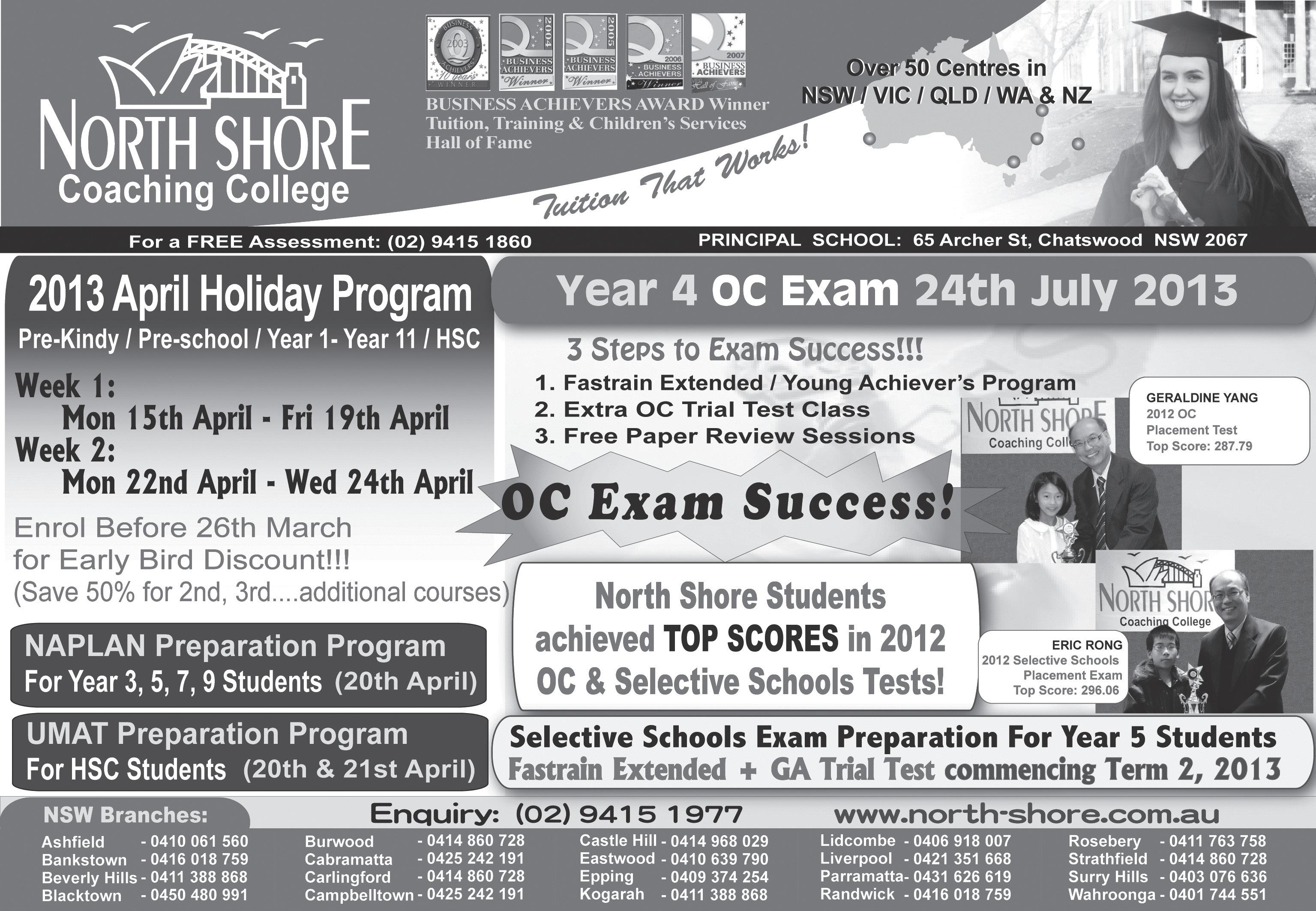
48 MARCH (1) 2013 www.indianlink.com.au


MARCH (1) 2013 49 NATIONAL EDITION
BY PETRA O’NEILL
Do you take white or brown sugar with your flat white?”
I was asked, and it might not seem an unusual query, except that I was within the grounds of Wat Chiang Man in Chiang Mai province as monks were chanting their morning sutras, their voices a low and murmuring drone. It is impossible not to feel the pull of centuries, the timelessness of this ancient city though modern day Chiang Mai in Thailand is a city of juxtaposed contradictions from traditional to hip chic, serene to chaotic, old to new.
The ancient kingdom of Lanna, meaning a million rice fields, was an agricultural empire of villages, unified by King Mengrai in the 13th century and ChiangMai, founded in 1296, became its capital.


Blessed with a cooler climate than Bangkok and buffered by mountains, Chiang Mai remained isolated until the railway opened
Chiang Mai in Thailand’s north is an archaeological adventure and a shopper’s paradise

in the 1920s. A recent influx of artists and designers has turned it into a vibrant destination with galleries and boutiques, spas, bars and restaurants that compliment the architecture and rich cultural heritage to be found here.
Though much smaller than Bangkok, Chiang Mai boasts almost as many wats (monasteries) built from the 13th to the 16th centuries when it was a major religious centre for Theravada Buddhism. While many were altered by the Burmese who ruled the city from 1558-1774, the architecture still epitomises the Lanna style with features such as elaborate dark wood carvings on temple pillars and doors.
I started one of many walks at Wat Chiang Man, the city’s oldest temple, built in 1296 with its fine Chedi supported by rows of elephant buttresses; to Wat Chedi Luang, completed in 1481, which houses a giant stupa damaged by an earthquake in 1545. Within the old city walls you will find many more wats, including Wat U-mong, Wat Phra Singh dating from 1345 with exquisite woodcarvings with a lion Buddha, the city’s most revered image; Wat Suan Dok notable for its white Chedi; and Wat Saen Fang influenced by Burmese architecture. You
will also find teak wooden houses, many over 100 years old, characterised by low hanging latticed eaves, slatted shutters and wide verandahs.

On the city’s outskirts, Doi Suthep is the town’s holiest temple that dates from the 14th century, set atop the area’s loveliest mountain range reached via 304 steps, topped by a glittering golden Chedi. On a clear day, the temple affords views across northern Thailand, though the view was obscured by a thick haze on the day I visited it. Also worth a detour is Wat Chet Yot characterised by its square Chedi with seven spires, the design inspired by the temple at Bodhgaya, the site of the Lord Buddha’s Enlightenment.
While the night market is popular with tourists, Waroros Market has been selling fresh produce for over a hundred years, while fabric shops, quirky boutiques and gift shops are nearby. Also, the small Hmong hill tribe market beautiful finely woven embroidery that seems quite old judging by the slightly faded colours, sadly cut up into saleable pieces.
With its mountainous terrain, Chiang Mai has become a base for adventure sports including white

water rafting, trekking and cycling and offers cooking classes, visits to hill tribes and elephant rides.
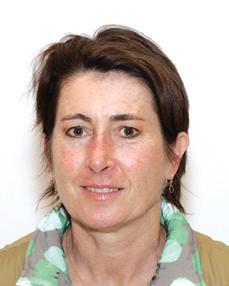

Lisu Lodge, an hour’s drive north is nestled in a green valley with views overlooking lush terraced rice fields and hills where life remains slow paced. Lisu and Akha, hill tribes originally from Tibet live here, and I enjoyed leisurely bike rides along quiet country lanes to visit their villages. I enjoyed a ride on a gentle mother elephant with her young offspring nudging her as it walked alongside, pausing periodically to drink and splash water as we sauntered besides the river’s edge. The white water rafting trip downstream was exhilarating, with the small Thai boy seated in front of me laughing with excitement!
On arrival at Khum Lanna lodge I was provided with a perfect introduction to traditional northern Thai cuisine, with a tour of the organic vegetable and herb garden, before being set to task to cook a delicious four-course dinner. Northern Thai cuisine incorporates Burmese cuisine, my favourite is the coconut milk soup. A Thai massage provided to all guests by women from the nearby village was the perfect way to end the day, too relaxing to be jolted into consciousness at 4.30am by
Buddhist chanting from a nearby wat, followed by a 5.30am wake up call for a bike ride through the countryside to Phrao town market. But as I sipped on a cup of heady organic locally grown coffee with a large dollop of condensed milk, I thought that rural Thailand, with its hill tribe villages, terraced rice fields and unhurried pace is an altogether enjoyable and restorative destination.
50 MARCH (1) 2013 www.indianlink.com.au
TRAVEL
Travel noTebook CHIANG MAI
Ge TTING TH e R e
Thai Airways International flies to Bangkok with convenient connecting flights to Chiang Mai. Buses and trains depart from Bangkok regularly.
Ge TTING ARO u N d
While I preferred to walk, bicycles are a great way to get around within the old city. Taxis and mini buses are inexpensive. Lodges will arrange transfers.
W H e R e TO s TAy
Visitors are drawn to Chiang Mai not only for its beautiful wats, but also for shopping and exquisite boutique hotels that are well worth the splurge. The Rachamankha offers refined elegance, antiques from the owner’s private collection and successive flowing courtyards. T: 66-5390-4111; email: info@ rachamankha.com; or visit www. rachamankha.com


The chic and tranquil Chedi hotel has a sleek contemporary design, spacious public spaces, a relaxed ambience, welcoming efficient staff and landscaped grounds overlooking the Mae Ping River. The Club Lounge is worth the extra, the restaurant serves the best Indian cuisine in town as well as Thai dishes from where you can enjoy watching the boats go by. The Spa with highly trained therapists is absolute heaven. I wish I could have stayed longer. T: 66-5325-3333; email:chedichiangmai@gmhhotels.com; or visit www.ghmhotels.com


More moderate accommodation includes the Galare T: 66-53-81-8887 email: info@glare.com; website: www.galare.com and the 3 Sis Bed and Breakfast 66-53-273243; email: 3sis.bng@gmail.com; website: 3sisbedandbreakfast.com
Having served as a backpacker’s haven since the 1970s, modest guesthouses are clustered in several areas, with Lamchang House a good choice T: 66-53-210586.

Near Chiang Mai are many beautiful resorts and lodges. Lisu Lodge set in a beautiful tropical landscaped garden is a great example of sustainable low impact tourism. Khum Lanna in a rural setting focuses on cooking using ingredients from its organic vegetable and herb garden. All meals and activities are included. T: 66-53-278338; email: info@asian-oasis.com website: www.asian-oasis.com

dINING
While restaurants at hotels are generally very good, restaurants overlooking the Ping River on Charoenraj Road including The Gallery, are recommended.

W HAT TO buy
Designer boutiques line Charoenrajd Road. Warorot Market and the boutiques nearby are more affordable. The Hmong market has some great buys.
I enjoyed a ride on a gentle mother elephant with her young offspring nudging her as it walked alongside, pausing periodically to drink and splash water as we sauntered besides the river’s edge

Though much smaller than Bangkok, Chiang Mai boasts almost as many wats built from the 13th to the 16th centuries when it was a major religious centre for Theravada Buddhism
 From left to right: Wat Chedi Luang, Lisu Lodge, Elephant ride, Scenes from the Chedi Hotel, reclining Buddha, farm near Lisu Lodge, Akha woman.
From left to right: Wat Chedi Luang, Lisu Lodge, Elephant ride, Scenes from the Chedi Hotel, reclining Buddha, farm near Lisu Lodge, Akha woman.



52 MARCH (1) 2013 www.indianlink.com.au Register you interest today: Mr Sanjay Agrawal Contact number: 03 9413 1481, Mobile number: 0402 023 502 Email: sanjay.agrawal@unitedpetroleum.com.au

MARCH (1) 2013 53 NATIONAL EDITION
Off the couch and into the kitchen
Attempting a special dish in the kitchen with success is a real-time experience, unlike foodie TV shows
BY AVI CHANDIOK
know it’s sacrilegious to show even a sneaking dislike of food programmes on TV but I ask for forgiveness in advance, being one of the few who would rather not watch them. It’s almost unheard of to press the ‘off’ button or change channels when these programmes are on. Cooking shows have taken the airwaves by storm and provided a rich source of content for the media. Don’t get me wrong, I have no objection to others enjoying these shows, but they are not for me.
Crème Caramel
200ml milk
200ml cream
3 eggs
40g sugar
1 tsp vanilla essence
For caramel
110g caster sugar
4 tbsp water
Fill a large bowl with water. Keep aside for later. Warm a soufflé (oven-proof bowl) dish in the oven at 150C.Whisk together eggs, sugar and vanilla essence in a bowl.
Combine milk and cream in saucepan and heat till steaming hot, but not boiling. Pour into the mix and stir gently until well combined.
Put caster sugar and water in another saucepan over gentle heat and stir gently until sugar dissolves. Raise the heat
to medium until the mixture turns golden brown. Remove from heat and dunk the bottom of this saucepan in the large bowl filled with water. This prevents the caramel from continuing to cook as it can burn fairly quickly.
Remove the heating dish from the oven and spoon caramel into it. Caramel starts to solidify quickly so heat the saucepan gently to soften remaining caramel and add it to the bowl.
Pour the liquefied mixture into the bowl on top of the caramel liquid. Place this bowl in a roasting tin and add water, upto 2/3rd of the depth of the contents, into the tin, taking care that none falls into the caramel bowl. Place the roasting tin in the oven for 45min at 180C. After 20 minutes,
check to ensure that the top of the mix is not getting browned. Remove roasting tin with bowl from oven and leave to cool, then place only the bowl of the mix in the fridge to cool until chilled. Your crème caramel is ready. To serve, carefully run a palette knife around the edge of the bowl to release the pudding. Place large dinner plate upside down on the bowl. Holding the bowl with the covering plate, turn both upside down in one steady, quick movement (I do this over the kitchen sink!)
Remove the bowl to reveal the crème caramel covered with its golden brown sauce sitting on the plate. Serves 6.
A recent count of shows on eight of the main TV channels during primetime in a single week showed that over 10% of peak viewing time between 6-9pm is devoted to food programmes. But there are a variety of shows filmed in all parts of the world ranging from farming on small-holdings and raising cute, healthy animals and birds destined as produce, to the art of entertaining with family and guests having a real jolly time of it and, of course, chefs in kitchens doing their thing. What’s next, where do producers go from here as they try to leverage every bit of audience from this genre? Cooking in outer space, on Everest or even underwater may be on the cards, for our entertainment.

There is no doubt that all this interest has raised the awareness in all aspects of what we eat and how things grow. And that is not a bad thing. Yet obesity rates only seem to be on the rise in our society. A look at newsagents’ racks shows a proliferation of magazines on cooking and food, while the internet is awash with blogs, sites and YouTube demonstrations of recipes. It’s almost as if there is a huge industry at many levels, and participants have been able to cash in on the coat-tails of this interest in food. But we mustn’t lose sight of the fact that there are only so many people and they can only eat so much. It’s not as if more food is being cooked, or is it?
To get an answer to the question above I decided to take a look at some government
numbers. They revealed a fascinating picture. They showed that in 2009-2010 expenditure on supermarkets and groceries rose by 2% over the previous year, but well below the long-term trend. The conclusion is that relative to previous years, people must be cooking less or using cheaper ingredients. And would you believe it, the next set of numbers showed that the growth in expenditure on takeaway foods, cafes and restaurants had skyrocketed and more or less doubled its long-term trend. This tells us at least two things. Of course, the more prosperous the economy, the more people will eat out. To me this ties in with a vision of people sitting around in cafes and restaurants with their smart phones and iPads, and this is more or less what one can see most times of the day. But what sticks out like a sore thumb if one believes the numbers, is that people must be cooking a lot less than they used to, contrary to what one might expect from this apparent mushrooming of interest in cooking.
Sharing a meal with friends is undoubtedly one of the real pleasures of life. When all the food has been cooked and enjoyed, good-byes said and the guests have gone, you sit at the table and drain that last sip of wine that remains in your glass. It’s peaceful now and you sit in quiet contemplation of the evening and then reality strikes –yikes, these endless piles of dirty plates and glasses. Yes, clearing-up is next. Ever an integral part of cooking and entertaining, will we see a show on this part of the process? I don’t think so!
Who is to really say what people are getting up to in their kitchens and with their eating habits. For my part, I am grateful to have a nice, square meal every day. A while back I had a hankering for crème caramel. Do you think I could find it anywhere – no, not on your life! It surprises me that most restaurants do not serve this heavenly dessert. I had no choice. I picked up a recipe book, put on an apron and after some hesitation and a little tension, I made something which still had to be turned upside down. Plop, out it came. Much to my delight it looked just as a crème caramel should, the taste was divine and since then my popularity amongst my family has increased no end. Cooking – I’m beginning to like it!

54 MARCH (1) 2013 www.indianlink.com.au F oo D



MARCH (1) 2013 55 NATIONAL EDITION Suite 1, 71 A Macquarie street, Parramatta. Phone: 0411 520 546 02 9687 9741 For expert coaching in • Money completely refundable, if not satisfied with the first tuition session. • Lowest fee Guaranteed. • Power packed sessions *Conditions apply ( enquire before enrolling). ENGLISH GURU www.englishguru.com.au IELTS Guarantee Course* or One / Two Weeks Crash Course Enrol today in the Band Score
THE BUZZ
Make way for Munnabhai 3
Is anyone out there missing Munnabhai? Well, it’s good news for fans of the character, as filmmaker Subhash Kapoor has been roped in to direct the third instalment of the highly successful Munnabhai franchise. The film will go on the floors early next year.
The first two films –Munnabhai M.B.B.S. and Lage Ragho Munna Bhai – were directed by Rajkumar Hirani. And the unusual jodi of sanjay dutt and Arshad Warsi made the films enlightening and entertaining, with boman Irani thrown in for good measure. But these super successful films were made in 2003 and 2006 respectively, so it’s been a big break for the iconic Munnabhai. And which issue will he tackle next, the upcoming election? Kapoor is reluctant to comment.
“Right now only one thing has been finalised that I will be direct the film. Nothing more than that,” he said. Naturally the trio of Sanjay, Arshad and Boman will be a part of the film. The leading lady is also yet to be finalised.
Kapoor’s ongoing Jolly LLB also stars Arshad and Boman along with Amrita Rao in the lead roles. Laced with humour, the film is a satire on the country’s legal system, and will release in mid-March. So let’s get ready for some more Munna capers!
Desi Gangnam is gift for dad
Actor Jackky Bhagnani has an unusual gift for his dad, producer Vashu Bhagnani, regardless of whether he may want it or not! It took Jackky a long time to get the rights to Korean singer Psy’s superhit number Gangnam Style for his film Rangrezz, but he finally clinched the deal. directed by Priyadarshan, Rangrezz releases on March 22, and features actress Priya Anand opposite Jackky.

SHILpA SHETTy IS WELLNESS ICON

An elated Shilpa Shetty was named the Wellness Icon at the NdTV Good Times Lifestyle Awards 2013 in Greater Noida recently. The actress and reality TV star is married to businessman Raj Kundra and has a nine month old baby boy called Viaan. Shilpa tweeted that she is happy to continue inspiring
people in the field of wellness and fitness. She received the trophy and certificate looking fit and fabulous in a green leopard print dolce & Gabbana dress. It’s interesting that the actress was picked among so many of her seemingly equally fit contemporaries. But good job Shilpa, show us how it’s done!
“I thought that Indians should also have this song. so I started a conversation, which took three months. When I got the papers signed finally, I took them to my dad and said, ‘you have done a lot for me and I have got a gift for you’. He was shocked to see that gift,” said the 27-yearold actor.
“We call it Desi gangnam,” said the actor, who admits he is now “trying to establish my own identity.” Not too sure how he’s going to achieve that considering that Gangnam Style is now last year’s style! A good gesture, but a tad late, Jackky!
But as it’s desi, maybe Jackky will make the song trendy again. Good luck with that, Jackky!
Directing SRK is on John’s wish list
John Abraham turned producer with Vicky Donor, so can direction be far from his thoughts of progress in Bollywood?
Not really, as the hunky actor admits that direction is also a part of his plan, and he would especially love to direct superstar shah Rukh Khan some day. “I think I will do a fairly decent job directing, because I feel I have a vision and I would like to get that across,” the 40-year-old said.
“I would love to direct shah Rukh! (He is) very interesting and very charismatic… I would not like to play on his strengths, but I would like to get something else out,” added John.
Generously, John admits that other actors are also interesting to direct. “Aamir (Khan) directs himself, so that’s interesting about Aamir. Each one is different and probably if I am doing a fun film, may be Akshay Kumar. but I am not thinking about it right now, so it’s completely hypothetical. I may (also) direct newcomers,” said John.
His latest release I, Me aur Main hasn’t done that well at the box office, so it’s likely that the dream of directing may become a reality sooner than later! Good luck, John!
Charm in character, insists Soha
Soha Ali Khan is almost as outspoken as big brother Saif when it comes to the film industry.

The actress recently made it clear that she doesn’t believe in the ‘hero-heroine dynamics’ of bollywood. Instead, the actress prefers a character-driven role in a movie, even if she doesn’t get to play the protagonist’s role.
“I look for character-driven scripts. I find the words ‘hero’ or ‘heroine’ very absurd. We all play characters,” said the outspoken actress in an interview recently.
Even her debut Bollywood film Dil Maange More, released in 2004, reflected this choice. “When I did my first film, I chose the character of a girl who chooses her career over the boy. But then everyone was like, ‘you are not the heroine of the film! She has to get the hero.’ but I felt the other role was more interesting,” Soha said.
56 MARCH (1) 2013 www.indianlink.com.au
Up-to-date news on what’s hot and happening in Bollywood ENTERTAINMENT
Jacky Bhagnani
The 34-year-old daughter of veteran actress Sharmila Tagore is appreciative of the kind of cinema the Indian film industry is witnessing currently. “It is not star-driven. It is script and plot-driven... this is more exciting for me,” she said.
Soha has been a part of offbeat films like Soundtrack and Midnight’s Children as well as commercial films like Rang De Basanti and Tum Mile. And she is happy the lines between the two are blurring gradually. “In the 1970s, there was commercial cinema and parallel cinema. Now that line is not so clear. Good films work at the box office, with offbeat subjects or actors. So the distinction is blurred now,” she said.
“I want to be part of good cinema...with songs or without songs, with or without

masala, with or without Salman Khan. The story should be good, the character should be good. Whether it works or not is secondary,” she added.
Soha also admits she regrets being a part of some films, but she doesn’t allow herself to dwell on it too much.
“There is no point regretting anything. I don’t look into the past. Of course, there are films which I have done, which have not worked. but I don’t dwell in those,” she said.
Soha will be seen next in Tigmanshu dhulia’s Saheb Biwi Aur Gangster Returns
But if there’s one thing that annoys this actress, it’s references to her royal background. ‘don’t rub in the royalty, please!’ seems to have been Soha’s underlying statement when, while promoting the new film, she made her displeasure clear at her royalty references being relentlessly rustled up. director dhulia put his foot in it when he said at the event that he chose Soha to play a princess in his film as she looked every inch the royal in royal finery. To this, the

WHO WORE IT BETTER?
sharp-tongued soha retorted, “Oh yes, I even sleep in royal clothes.” explaining her snappy response, soha said, “It is true. When I was asked if I was comfortable playing my character because of my royal background, I did respond that way. but I was being facetious in merely stating how ‘unroyal’ my dress sense is. As a matter of fact, I am so bohemian in my dress code that only recently have I started wearing shoes instead of chappals. so I was actually making fun of myself!”
Naturally, Soha added she is very proud of her royal antecedents. “I embrace my identity. It is a privilege to come from the background that I do,” said the daughter of the late Mansoor Ali Khan Pataudi, who was nawab of Bhopal until 1971, when India abolished royal entitlements.
Well, we’ll be seeing princess Soha in royal style soon!
Urvashi impresses in debut film
Urvashi Rautela is just 18, but has already impressed director Anil Sharma with her debut performance in Singh Saheb


The Great Sharma believes she has a long way to go. “As the leading lady in the film, Urvashi has done a wonderful job. So let us welcome this new girl with all our good wishes,” he said.
Urvashi is said to have replaced Ameesha Patel in the movie, and will be seen romancing sunny deol, who is 38 years her senior.
Urvashi was in the news for winning the I Am she Miss universe pageant in 2012, but she had to give up her title because she was found to have been 25 days below the minimum age limit of 18 years.
Sharma, who had earlier directed Ameesha and Sunny in Gadar: Ek Prem Katha, says Ameesha was never signed on for Singh Saheb The Great “She was supposed to be a part of the film, but officially we never signed her. It was very much a media created news,” said Sharma.
Looks like Urvashi has had more success with Bollywood than beauty pageants. Good luck to her!
What’s the chitchat between Ranbir and mum Neetu?

LAST ISSUE CApTION CONTEST WINNINg ENTRy
What’s Saif saying that’s making SRK laugh so hard?


Saif: Buddha ho raha hoon, don’t know if I’ll get a Filmfare Awards hosting role again.
Rashida Afzal Enmore NSW
Rashida wins a double ticket to new Hindi film release
I,Me Aur Main
MARCH (1) 2013 57 NATIONAL EDITION CApTION CONTEST
Send in your responses to info@indianlink.com.au and win a surprise prize
Soha ali khan
John aBraham
UrvaShi raUtela
katy Perry and Sonam kapoor in Dolce and Gabbana. Share your views with us on our Facebook page
CINE TALk
without making a song and dance, cinematography by Anay Goswami and eepa bhatia that says it all without a single shot being redundant, and most of all, a terrific gallery of actors who make the brotherly bonding look so real you feel other celebrated films about male bonding (including Abhishek Kapoor’s Rock On) were mere
And yet to describe Kai Po Che as a film on male bonding would be akin Dr Zhivago as a film on the medical profession.
Taking the core idea from Bhagat’s novel, Kapoor weaves together a tapestry of thoughts, characters and lives that embrace an entire ethos and culture without sacrificing individuality.
Fearless and almost flawless, Kai Po bubbles over with the warmth of lived-in experiences and with central performances that are so unstudied you suspect the actors were born to play
K AI P O C HE
SpIRITS SOAR SkyWARDS
STARRInG: Sushant Singh Rajput, Raj Kumar yadav, Amit sadh, Amrita Puri
DIRECTED By: Abhishek Kapoor
HHHH
It really can’t get any better than this, can it? The year has just begun and we have one of the finest, most vibrant and fulfilling coming-of-age films in living memory.
Kai Po Che (the war-call uttered during kite-flying in Gujarat) is not about kiteflying. In fact there is just one fleeting sequence, very effectively positioned in the meticulously structured narrative, where the characters actually fly kites.
Kai Po Che is about spirits soaring skywards, as the characters - each one so vividly etched into the compact narrative that you come away with people whom you will probably carry with you for keeps - let their spirits roam wild and free, soaking in the sunlight of desire, longing, aspiring, stumbling and getting back on the feet.
Set in Gujarat during times of peace and unimaginable stress, Kai Po Che takes Chetan Bhagat’s engaging novel about friendship among three dissimilar young
people struggling to find their voices in Gujarat in and around the year 2000, and converts the written word into an enrapturing entity far beyond just a story well told.
The three, joined by a fourth - a girl who happens to be the sister of one of the heroes secretly involved with the hero’s best friend - bring to life a world where the accidents of existence collide gently but powerfully with man-made and natural calamities that shake the very existence of an Indian middle class, living on an edge where toppling over the abyss is a real possibility.
Sure enough, by the end of the film one of heroes Omi (Amit sadh) does fall into the abyss of bigotry. Though he is finally given a chance to redeem himself, it’s too late. A dream has already died, though another one is reborn.
Kai Po Che is about the shared aspirations of three friends: the reckless and devil-may-care cricketer Ishaan (Sushant Singh Rajput in a remarkable film debut), his cautious, shy friend Govind (Raj Kumar yadav) and their somewhat confused friend Omi, the son of a liberal temple priest who tilts towards Hindu radicalism more out of an economic necessity than a ideological
imperative.
Into these lives, screenplay writers Abhishek Kapoor, Chetan Bhagat, Pubali Chaudhuri and Supratik Sen introduce a socio-political perspective that is rare in mainstream Hindi cinema.
There are many reasons why Kai Po Che is one of the most compelling products of the post-renaissance era in Indian cinema. To my mind its greatest achievement is its fusion of “cinema” and “history”, a synthesis that filmmakers today would consider unpalatable for viewers. Hence they serve up the junkfood equivalent of cinema. Quickly ingested and easily forgotten.
Not this time!
In Kai Po Che, the characters and situations created to bring out the personality conflicts emerge from the two crises points in Gujarat’s history - the 2001 earthquake and the post-Godhra carnage in 2002.
The sustained palpable tension of the riots towards the concluding lap of this riveting tale is the stuff that great cinema is made of.
The virtues of the film are many: songs (Amit Trivedi) and background music (Hitesh Sonik) that seem to echo the protagonists’ inner world
Among the trio, Amit Sadh as the fence-sitter turned Hindu radical gets into the skin of his character and remains there till the end, and not for the first time. He was also admirable as a narrator-journalist in Kabeer Kaushik’s . Here’s an actor who deserves yadav as the voice of reason among the trio of friends yet again displays his amazing ability to come to grips with the body language, speech and inner world of the people he plays. I’ve not seen any actor deliver his lines in recent memory so naturally without artificial punctuation. Raj Kumar’s triumph is the triumph of refined acting in Hindi cinema.
And let’s not forget the talented the spontaneous Amrita Puri as Ishaan’s sister. She is at the periphery of the pivotal axis and yet makes her presence felt with such an endearing lack of vanity.
As for Sushant Singh Rajput, the script favours his character. And he repays the compliment right back, with bonus. With his compelling screen presence and an ability to render restless energy in a restrained pattern, he immediately establishes himself as one of the most articulate actors of the post-Ranbir Kapoor generation.
His relationship with the cricketing prodigy Ali (digvijay deshmukh) is in many ways the core issue of the multifarious plot. you cheer for Ishaan’s streetwise heroism in a way you haven’t cheered in a long while.
Take a bow, Abhishek Kapoor. you have proven that Rock On was no flash in the pan. Kai Po Che takes the theme of friendship to another level.
Yeh dosti hum nahin todenge, indeed. Sometimes the best of friendships get swept away in politics and history. It takes a master storyteller to remind us that cinema is finally a mirror of forces which have a bearing on life.
Kai Po Che just tempts me to tell the escapist merchants of Bollywood to go fly a kite.
S UBHASH K. J HA

58 MARCH (1) 2013 www.indianlink.com.au
ENTERTAINMENT
ODE TO MAyHEM AND MACHISMO
Z ILA G HAZIABAD
STARRInG: sanjay dutt, Vivek Oberoi, Paresh Rawal, Arshad Warsi, Chandrachur Singh, Ravi Kishan, divya dutta
DIRECTED By: Anand Kumar HH
Wasseypur’s gangs never had it so good. Seeing the glorious guttural outflow of blood, bullets and profanities in Zila Ghaziabad one could safely assume, Wasseypur is safe. So is the other release this week.

Abhishek Kapoor’s Kai Po Che is as far removed from its Friday competition as flying kites is from a hail of bullets.
To be fair one can’t compare two films as disparate in intent, purpose, tone and treatment as Kai Po Che and Zila Ghaziabad ... except for the fact that somewhere down the line as we approach the crux and the core, both films say the same thing. If you want to survive in this cut-throat world, you have to recognise your own weaknesses and strengths -- not that one sees the hurried restless unanchored
strangely identity-less and vapidly violent characters of Zila Ghaziabad ever doing any introspection.
Where is the time to sit and think when everyone is out for a kill? The biggest casualty in all this gore-mongering is a logical pattern of storytelling. The material is edited more to accommodate optimum punches and punchlines than to tell an anchored story. The narration leaves no room for any kind of emotion to take root.
We meet the characters as blood-thirsty creatures of the underground. And we are most happy to leave them to their internecine intentions. This is the kind of staged drama where lawmakers and lawbreakers behave with equal impunity. Both sides are wedded to anarchy. Screw the emotions. This is an orgy of elemental escapades.
And that’s where the fun side of the film unleashes with fatuous fury. The
action director is the real conductor of this disorderly orchestra. One violent outburst follows another as two clans of Zila Ghaziabad battle it out to a bloodied end.
Admittedly, the action is staged with a whole lot of gusto. Tragically, the underlining humour of Salman Khan’s Dabangg is missing here. These scowling, growling, barking and biting characters take themselves and their anarchic hinterland too seriously. They speak in a self-confident drawl in words about bodily functions that Vishal Bhardwaj or Anurag Kashyap’s characters might use on a lazy Sunday to shock their neighbours. But make no mistake. The people who inhabit Zila Ghaziabad mean business.
The business of being mean is perpetrated in a torrent of rapidly-staged drama where aggression is King. The film has a sprawling banquet of actors, and some very competent ones at that. sanjay dutt delivers a punch-filled performance as a cop inured to ambivalence. He strikes swaggering postures that suggest John Wayne never really hung up his hat and boots. Vivek Oberoi, who was gloriously goofy
as a bumbling gangster in last week’s underrated Jayantabhai Ki Luv Story, here displays a mean streak quite convincingly.
So does Arshad Warsi, better known for his comic acts, here slipping into a rugged roguery with relish. If you look around, Chandrachur Singh and Paresh Rawal also show up to add muscle to the mayhem.
Every character seems to have fun with his part in this Khichdi Western, a distant doomed spiced-up teekha cousin of the celebrated ‘Spaghetti Western’, though whether we as the audience share the characters’ sense of enjoyment or not depends entirely on the frame of mind we are in.
If judgemental, one could be deeply offended by the unstopped flow of aggression and profanity. However, if in a lenient mind-space, the bloody battle for indeterminate causes could provide some amount of lowbrow fun.
As expected, in this ode to mayhem and machismo, the ladies have little to do besides shake a leg and shed a tear. Minissha Lamba shows up somewhere along the way trying hard not to look lost in the stag party.
It’s hard not to laugh out loud at these heroes of a subverted hinterland who live and die by the gun. They deserve the death they get.
But what about us?
SUBHASH K. JHA
TENDER ROMCOM LETS yOU DOWN gENTLy
I, M E AUR MAIN
DIRECTED By: Kapil Sharma HH
What do you with a selfobsessed guy like Ishaan who shoulders no responsibility except that to his iron-board torso and matinee-idol posturings, who takes everyone from Mom, Sis and girlfriend to success, friendship and karma, for granted?
John Abraham plays the kind of narcissist whose life is just waiting to fall apart. It does soon enough, leaving him... well, high and not quite dry.
For much of its economical playingtime, I, Me Aur Main glides along innocuously in an urbane corporatised haze where women are allowed to be successful alongside men, though that success comes with a price.
Hence to no one’s surprise, Anushka (Chitrangda) locks Ishaan (John) out of her home and life. Ishaan doesn’t waste a moment in moving into a new apartment where he begins anew with flirty neighbour Gauri (Prachi desai).

This is dangerously thin ice for a desi romcom to tread on. The principal characters do not aspire to any higher ground of existence beyond what they
are allotted by writers.
director Kapil sharma’s film derives some succour from urbane dialogues that the characters throw at one another at work and in parties.
Indeed the most interesting character to be obtained in this romcom is that of Ishaan’s frosty saree-clad, self-styled diva boss Beena (Raima Sen) who takes over the business and has poor Ishaan by his balls.
It is interesting to see John play a complete jerk, the kind unfortunately girls of a certain age do fall for.
John plays the trashy Ishaan without reservation - you wonder how this self-serving ass will finally get his comeuppance.
The payback comes in unexpected ways. The way an executive lifestyle and its sterile relationships are kept afloat in the film, are proof of intelligent minds energising this endeavour which strives to titillate but gradually falls into the terrain of torpidity with no hope of a rescue.
John as the commitment-phobic cad skims over the smooth surface unable to nail the character beyond the occasional smirk and the constant gleam in the eye.
His character evolves gradually, though, with fatherhood fuelling a sudden change of heart that would have been more convincing had Ishaan’s growth from self-obsession to
caring been charted a bit more boldly.
d welling in the domain of surfacelevel emotions, I, Me Aur Main tickles our fancy just enough so we do not walk away with a sense of betrayal.
John works hard to give character to his amoral character. His mumbling monologue at the end with his newborn is touching.
Chitrangda smoulders with her bridled sex appeal exuding oomph without letting any of it spill over.
Prachi literally plays the girl next door with a warmth that wraps around John like a cosy shawl in winter.
Television anchor Mini Mathur and Raima Sen provide colour and character to a script that needed more motivation and a larger sense of responsibility in showing its protagonist go from irresponsible to the committed.
I, Me Aur Main is an inoffensive, tender rom-com about a selfish jerk and the
two lovely ladies who come into his life. With an endearing threesome of principal actors who aren’t afraid to play flawed, this film should have left us floored. Instead it just leaves us pleasantly underwhelmed.
S UBHASH K. J HA
MARCH (1) 2013 59 NATIONAL EDITION
STARRInG: John Abraham, Chitrangda singh, Prachi desai, Raima Sen, Mini Mathur

60 MARCH (1) 2013 www.indianlink.com.au
Shiva’s boon
The power of prayer and faith manifests itself into reality for the true believer
BY RANI JHALA
Why do you persist in tormenting me so,” Parvati’s mother lamented.
“What have I done now, mother?”
“Tonight is Maha Shivaratri, the great night of Shiva. It is a day of prayer and penance, but you want to go to the movies with your friends. Your presence is needed at home. You can tell your friends that you can meet them on another night,” she answered.
“Mother, I have no interest in either the prayers or the penance. I do not want anything, nor am I seeking forgiveness for any wrong,” Parvati replied.
“Of course, you want something! All unmarried girls want this. An early marriage and a good husband,” Narayani announced.
“And your Lord Shiva can give me that. In return for keeping me awake all night chanting his name, he will bless me with a good husband. And will this good husband of mine also be sitting up all night and praying for a good wife. Or does he have the privilege of having a boon granted without penance?”
“Don’t be silly, child, men do not have to worry about that. It is the privilege of us women to seek Lord Shiva’s blessing,” replied her mother.
“Mum, Dad left you to seek Mount Kailash and his god. What good did your prayers do for you? If I was you, I would ask for compensation,” said Parvati.
“PARVATI! That is enough!” Narayani screamed. Then, calming down she said, “Besides, that was my mistake. I used to cheat when I was young. Instead of saying my prayers I used to read novels.”
“I don’t believe you did it. And you never got caught?” asked Parvati, astonished that her mother would deviate from her moral path.
“No, we were good at it. But it was not the right thing to have done. All those novels I read brought me a good husband but I was cheated from a long life with him,” lamented Narayani.
“Mum, it has nothing to do with how well you prayed or how good you behaved. Men are human beings and have human failings and
aspirations. Unlike you, I do not hope for an ideal person. I want him to love me more than he loves God,” said Parvati.
“I do not begrudge your father his need for spiritual enlightenment, for when I finally learnt to pray properly I had asked for a husband who was wise and who also deeply worshipped my Shiva. We each have our own journey to undertake. And I can’t complain, he gave me a wonderful daughter and he left us well provided for,” Narayani justified.
“I don’t think it was how you prayed, mum, but what you asked for that may have been your downfall,” Parvati joked, then giving her mum a hug added, “I must remember to word my prayers properly if I ever have to deal with your Shiva.”
“Would you rather that I had married a womaniser, an alcoholic or an abuser? My Shiva gave me a good man. I have much to be grateful for,” said Narayani stoutly.
For the first time, Parvati really looked at her mother. Somewhere between her superstitions and her ritualism, her mother had found strength to fight life’s challenges and a faith that saw each challenge as a reward. Somewhere in between her prayer and Shiva’s boon, she had found peace and forgiveness.
Leaving these sombre thoughts behind, Parvati continued on a lighter note, “Well mum, if Shiva gave you a good man but for a short time, then we will pray that I find a ‘not so good man’ for a longer time.”
“There you go, acting foolish again. Don’t fool around with faith
and belief, my child. While other girls wrote Lord Ram and Lord Shiva’s name on the bilva leaves they offered in prayer, I wrote the names of my favourite actors. While they made garlands to adorn the Shivaling, I made one to decorate my hair. And while they fasted with sincerity, I would pinch the prasad from the shrine or pluck the fruits from the orchard,” Narayani recounted with shame.
Parvati smiled again. Her mother, who never broke a rule, was quite the imp in her youth. Then in an accepting voice she asked, “Ok mum, why don’t you tell me what your Shivratri is all about and maybe, if I am convinced, I might join you this year in the pooja.”
Narayani had waited for this moment for the past five years, in fact, since her daughter’s sixteenth birthday. Grabbing Parvati’s arm, Narayani led her to the prayer room and sat her daughter down next to her. Then pointing to the Shivaling she spoke of its significance as the creator. Looking at the photo of Shivji she related the tale of how to save mankind from the poison churned out from the ocean, Shivji drank it but held it in his throat, turning it blue and earning him the name Neelkanta – the Blue Throated One. Finally she lifted the statue of Shiva standing in a dancing pose with a ring of fire around him and told of his cosmic dance, called the ‘Shiva Tandav’, the dance he undertakes to display his omnipotent power as creator, preserver and destroyer.
Then she detailed how the Shivratri prayers are done. The Shivaling is first cleansed with

water, milk and honey, representing the washing away of bad emotions. Then vermilion paste representing virtue is applied on the Shivaling as a reminder to adhere to righteousness. The offering of the bilva leaves is symbolic of the surrender of oneself to the threeeyed deity. This is followed by the offering of fruits, which represents the offering of our desires. When these are given back as prasad, it represents the fulfilment of our wishes. Incense is burned to purify the air and to symbolically spread goodwill and success. Lamps are lit to symbolise the awaking of our inner being and the attainment of knowledge.
The Linga is also marked with the ‘Tripundra’, the three horizontal stripes made by smearing holy ash and symbolising spiritual knowledge, purity and penance. A rosary of Rudraksha seeds beloved to Lord Shiva and a statue of the Cobra snake are placed near.

Parvati listened carefully and then asked, “Why tonight of all nights?”
“Mythology says, Lord Shiva declared that the rituals performed by his devotees on the 14th day of the dark fortnight in this month please him the most. Scientifically, the planetary positions on this night are such that there is a powerful natural upsurge of energy in the human system. It is said to be beneficial for one’s physical and spiritual well-being. My mother believed it was the night Shiva manifested his physical form into the Linga form. Others have said it was the night Shiva married Parvati, hence girls pray to Goddess Parvati as well. Which is what you should
Somewhere between her superstitions and her ritualism, her mother had found strength to fight life’s challenges and a faith that saw each challenge as a reward
be doing, since you are starting so late on this journey. It might help you catch up, if you pray to both,” Narayani added with a laugh.
“Alright mum, but just to make it clear, I am going to pray because of you and not Him,” saying this, Parvati bowed in front of the shrine.
Narayani looked at her shrine, wiped the tears from her eyes and said to her lord, “You have a hard task ahead of you with this one. I was a piece of cake.”
Just then the doorbell rang. Parvati rushed to save her mother the trouble. A stranger faced her, a good-looking one who seemed to know about her for he said immediately, “Parvati, I have a letter from your father. I am a botanist and was studying plants in the Himalayan ranges when I met your father. As I left, he asked me to personally deliver this letter to his wife.”
Taking the letter from him, Narayani, who had now reached them invited him in.
Even without opening the envelope, Narayani knew what the contents would say. From a distance, her husband was fulfilling his last role as a father. Only that would explain why he had chosen this day, to send this man.
At that moment she heard the words that confirmed her belief. “Forgive me, I should have introduced myself earlier. My name is Shivaraj, Shivaraj Lingaraja,” he said.
The unopened letter fell to the floor, escaping Narayani’s trembling fingers. Her Shiva was once again granting a boon.
MARCH (1) 2013 61 NATIONAL EDITION
F iction
A huge Shivaling in Kota Rajasthan
SEEKInG GROOMS
Well settled/professional alliance invited from Australia/India for 41/165 unmarried charming Punjabi Khatri girl, family oriented and responsible, IT professional, working in Sydney. Australian citizen. Early marriage. Can relocate. Serious proposals only. Email profile with recent photo: sydgirl09@gmail.com
Hindu Garg Agrawal NRI parents of sydney-based NZ citizen daughter 38, 5’ 3”, well educated, IT professional, seeking qualified, well-educated Hindu professionals; daughter willing to relocate please respond: sashti@globalmatri.org
Well-settled Indian family looking for a suitable match for their 23-year-old dentist niece from India, Hindu, Punjabi, height 5’1”, looking to settle in Australia. Will be visiting Australia in July. Reply to goodnewsmarry@gmail.com
Suitable match for beautiful, slim, Hindu girl, 29th July 1981, 5’5”, graduate from P.U. Chandigarh, diploma in fashion designing. Working in Sydney, Belongs to a business family, brother well settled in Sydney, running own business. Looking for good looking, clean shaven, Permanent Resident / Citizen boy. Please contact with photo and details at: funny_mints@yahoo.com ; +919417072965 (India); 0422 669 082 (Sydney)
M at r i M onial S
Match in Tricity or Sydney for girl working in convent school, 5’ - 1”, April 1987, M.sc. IT, b ed., PGdCA, elder sister married and settled in sydney. details 9988211362, 0430 172 569.
Seeking Sikh boy, ready to settle in Sydney, for very beautiful slim girl 27/5’7” working in MNC, high income. Elder sister married, parents well settled in Sydney Australia. Contact with photo at sukhikaur2013@gmail.com
Seeking suitable match (from Australia, never married) for Hindu girl, 35 years, Chartered Accountant (non-veg), living in Australia over 25 years, with eastern and western family values. Please email with all details on ganesh2011v@gmail.com

Suitable well-settled/professional match for Punjabi Arora beautiful, never married, 39/166 qualified IT professional. GsOH with good family values. brought up in India. Working in MNC Sydney. Australian citizen. Early marriage. Serious enquiries only. Email details with photo: ausgirl101@gmail.com
Suitable Saraswat Brahmin, MBA, CA, dentist or professional with at least 5’ 9” tall match for our daughter, aged 30, slim, beautiful, 5’7” tall with fair colour. Graduate from well reputed university in accounts and commerce, further studying MbA. Ours is a well settled family. Contact partnersearch2707@gmail.com
SEEKInG BRIDES
Seeking bride for 31-yr-old, BTech, software professional, worked in USA , recently gained Aus PR, moving to Aus, currently working with TCS Mumbai, never married, belongs to God fearing cultured family. Please send details to: sandeepsinghnz@yahoo.com; phone: 0466 971 880.

Match required for 27-year-old good looking boy 6’4”, Australian citizen, working in a steady job as Records Officer earning modest salary, living in Sydney, students studying in Australia also are welcome to send their profile. Email at bahsyd8591@gmail.com
Seeking suitable match for 37 years, good looking Gujarati Brahmin boy, 5’7” Australian citizen caste no bar. born and brought up in Mumbai, India and moved to Sydney 5 years ago. Please email with details on ravi_p100@hotmail.com
Match required for a 48-yo, slim, clean shaven, Jat Sikh Aust PR living in Melb, working for a Bank, own house. I have no children but I don’t mind if she has children. Genuine enquiries only email: jat_sikh@hotmail.com
Single tall man, often travels with work, desires to meet attractive good character single or widow lady over 40 with a view to marriage. Apply PP GPO box 2336 Adelaide, South Australia 5000.
62 MARCH (1) 2013 www.indianlink.com.au
taRot



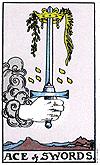
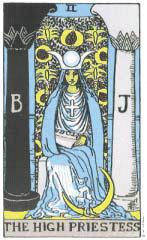


ARIES March 21 - April 19
you will find help from a co-worker who tries to help you deal with a problem, but the cards indicate that it may cause more confusion. Try not to feel upset or angry, as it won’t help. There can be romance in the air when someone reveals his or her true feelings for you. A Scorpio plays an important role. This month you will be feeling a little restless and overenthusiastic, so try and relax and let things flow.
TAURUS April 20 - May 20
you will manage to keep quiet about things that are upsetting you and this reticence will pay off. The cards indicate that a close friend will need to talk to you and will reveal some personal information. you will be thinking about a love relationship and wanting to know where you stand. There will be a very strong desire to ask your partner for a commitment, but Tarot advises take things slow and steady, and everything will work out.
gEMINI May 21 - June 20
The cards indicate that you will need to be patient at work this month. Make sure that you think about your best interests, as very often you do not always think about yourself and your own needs. Make decisions wisely. There is a real need to get things done and resolutions should be found. Lower back pain could be an unfriendly visitor this month. There is a kind of nagging pain: get it checked out, says Tarot.
CANCER June 21 - July 20
The cards indicate that you will be all too willing to try and help everyone out at work. A great new romance is on the cards for you, so be sure to make your moves. Financially you will be looking at some investments, and will come across some lucrative deals. There is a block of land near water that will catch your eye. you need to make sure you check the oil, water and brake fluid in your car.
LEO July 21 - Aug 22
predictions for MARCH 2013
By NANCy JADE ALTHEA www.nancysood.com
LIBRA sep 23 - oct 22
The cards show that you will be seeking harmony in the workplace this month. you are advised not to get involved in any office politics, easier said than done. Loved ones will look to you for advice and support. Take a deep breath. you will be able to help everyone out and still have time for yourself, Tarot knows. There will be some nagging health issues around an elderly member of the family. A blood test is required.




SCORpIO oct 23 - nov 21
The cards indicate that this is the month to follow your instincts in business matters. It is in your nature to tell the truth so stick to it, and don’t try to cover up as you will be found out. Love takes on a real twist as an old friend will resurface and want to begin a relationship. you too will have strong feelings. Just follow your heart. Tarot foresees a legal matter as needing your attention.

SAgITTARIUS nov 22 - dec 21
The cards indicate a time when you will need to be very honest and open with a close friend. your romantic life slows down this month, but don’t get discouraged. This break will give you time to relax and focus on yourself. you need to keep going to the gym or working out, as you are not feeling too healthy right now, Tarot suggests. Check on your diet and work schedule and make sure you are getting enough rest.
CApRICORN dec 22 - Jan 19
The cards indicate a great time for you at work. A great new opportunity will be presented to you. your intelligence and efficiency will shine through. Don’t be shy when it comes to meeting new people this month. your sweet, sensitive side will bring you close to someone with a lot of connections. you will be attracting a lot of attention from the opposite sex. Be careful of those around you, warns Tarot.
AqUARIUS Jan 20 - feb 18
This month, you will find that you have become a shoulder to lean on. you will be giving loved ones your support and attention. your caring, patience and support will be appreciated. It is a busy time for you at work, so make sure you give yourself a break. you will be planning to purchase a new car. There may be news of an engagement, foresees Tarot. Clear out your wardrobe and throw out things you do not wear.
VIRgO Aug 23 - sep 22
The cards show that you will be feeling very social this month. At work, you will progress as a team. you will also be meeting up with friends and will not feel like a hermit. There will be some lovely evenings spent with loved ones who will rely on you to take care of a family matter that is causing stress. There may be an Aquarius involved, Tarot suggests. you may be thinking about buying a new pet.
The cards show here that you need to allow your practical side to lead you in decision-making as the month begins. Do not make any hasty purchases. A relationship will move quite swiftly, and you will realise that you have a lot in common with that special person. There may be talk of an engagement. Tarot urges you to look after your health this month. you may join an evening class to learn a hobby.

pISCES feb 19 - March 20
The cards indicate that this month will be a time when you will feel a little trapped. you will take time out to relax and enjoy time with your loved ones, giving yourself a break from it all. Virgo and Sagittarius play important roles. you may be thinking about travelling for a while and just finding out what you want to do in life. Tarot suggests you will come across a soulmate to share your dreams.
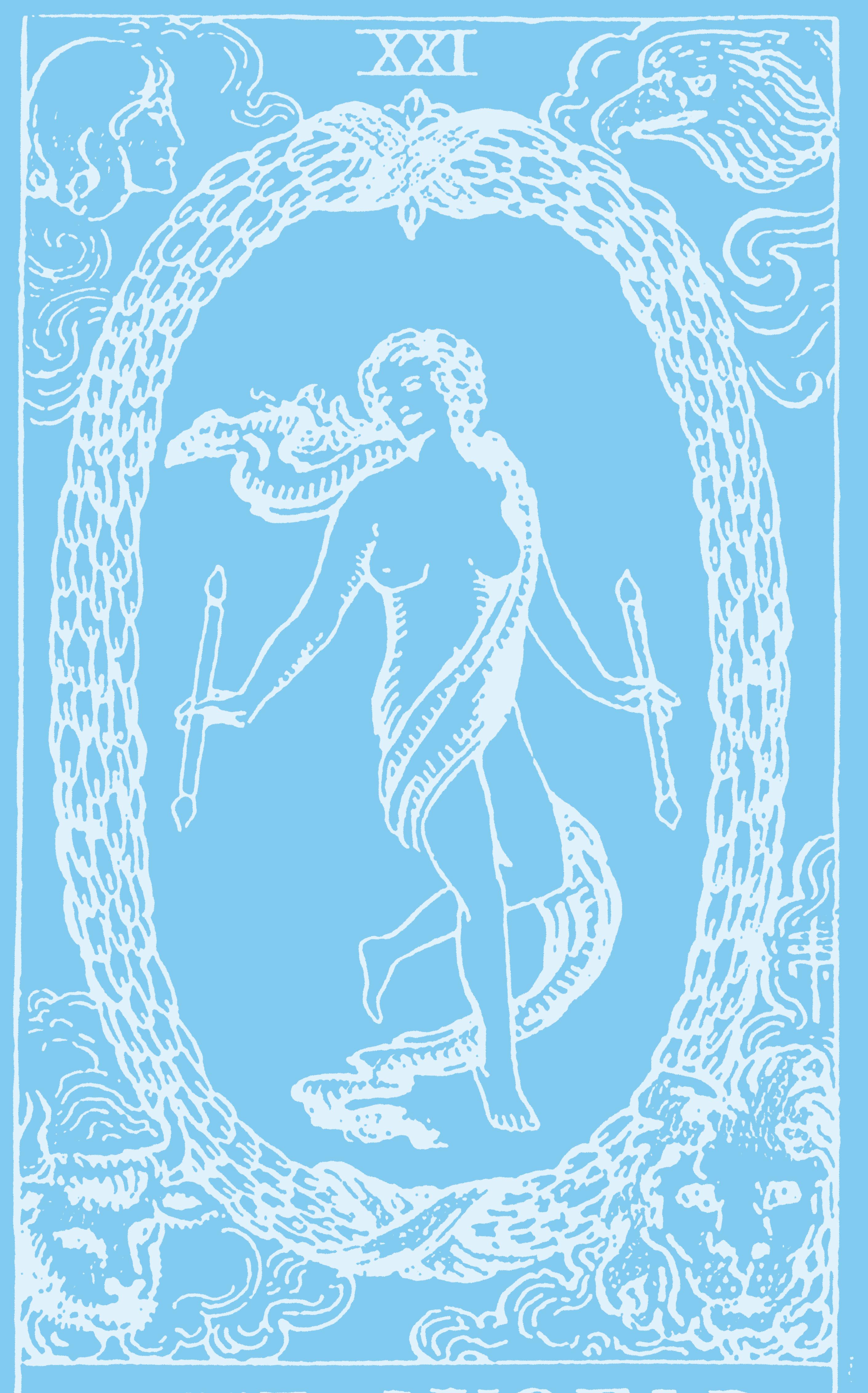
STARS FORETELL
did it ‘drive’ you crazy too?

It’s nerve-wracking and stressful, and way more challenging than actually driving on NSW’s roads
BY PRIYANKA TATER
By the time this article is published, I will have either earned rightful ownership of one of the most coveted possessions, ‘the NSW driver’s license’ or be sulking over what went wrong and why the testing officer couldn’t be a tad bit lenient.
Whatever the case, I truly and most sincerely believe that of all the examinations that I have taken in my life until now, the NSW driving test has been the most petrifying of all and has made me feel like a ‘good for nothing’ even before attempting it. Having said that, let me confess that the first bit, the computer test was a cake walk. Aren’t we Indians sheer geniuses at all things theoretical! While the guy next to me was venting colourful epithets after almost every third click, I found myself breezing through it and finished the test way before time.
Yes, I had done it, I had passed the DKT (Driver Knowledge Test) in one go. But was that the real challenge? For all of you who have gone through it, I bet you know the answer.
It was the next stage, the practical bit, the driving test that was sending shivers down my spine.
I had heard stories, real stories of how one can fail the driving test. One of my friends had shared her experience. She had barely started the car when the testing officer said, “You have failed, would you still like to continue?” “What? The car hasn’t even moved, how I can fail?” she quipped. Well, she hadn’t
moved the car, but had moved the rear view mirror to adjust it, after she had started the car. Rule broken = Fail.
Another friend who has been driving on Indian roads even before he started high school had committed a supposedly common mistake, stopped just past the stop line. Rule broken = Fail.
A regular listener who often rings in on my show on Indian Link Radio, Ruchika once shared with me on-air, how she had always been a topper all her life and how failing the driving test had shattered

decided to enroll myself in a driving school. Needless to say $60/hour did hurt, but as everything comes at a cost, so be it!

Now here’s another common ‘funda’ that we Indians tend to share: getting a ‘desi’ trainer to teach us the nuances of the Aussie rules. After all we share a bond, they would understand the psyche of a fellow Indian like no other Aussie trainer, and above all, have to give us some discount at least!
But let me warn you, experience has it that unless you are prepared to reveal your entire ancestry, every
Of all the examinations that I have taken in my life until now, the nSW driving test has been the most petrifying of all and has made me feel like a ‘good for nothing’ even before attempting it

was fielding those questions, I was getting to know ways in which one can fail the test. Start without the leg on the brake = Fail; don’t signal for at a least 5 seconds before leaving a parking space or moving from a kerb = Fail; and the list simply goes on. And then there is a list for loss of points too.
I don’t know how many of you have gone through something similar, but trust you me, if you were one of those who passed the test before things became so strict and difficult, consider yourself lucky.
With every lesson as much as I was fielding those questions, I was getting to know ways in which one can fail the test



64 MARCH ( bac Kchat
chat online OR call 1300 368 318 Email: info@paylessflights.com.au Cheapest Air Fare Book Online at www.paylessflights.com.au International and domestic Happy hours Every Friday Starting sharp 9 AM Till 9 PM


MARCH (1) 2013 65 NATIONAL EDITION

66 MARCH (1) 2013 www.indianlink.com.au

MARCH (1) 2013 67 NATIONAL EDITION

68 MARCH (1) 2013 www.indianlink.com.au











































 BY LENA PEACOCK
BY LENA PEACOCK













































 Sai Hasini Madukuri Darcy Road Public School, Wentworthville, NSW
Sai Hasini Madukuri Darcy Road Public School, Wentworthville, NSW










































































 From left to right: Wat Chedi Luang, Lisu Lodge, Elephant ride, Scenes from the Chedi Hotel, reclining Buddha, farm near Lisu Lodge, Akha woman.
From left to right: Wat Chedi Luang, Lisu Lodge, Elephant ride, Scenes from the Chedi Hotel, reclining Buddha, farm near Lisu Lodge, Akha woman.


















































